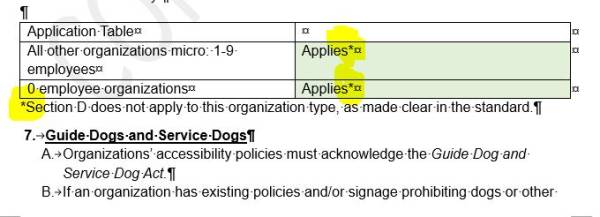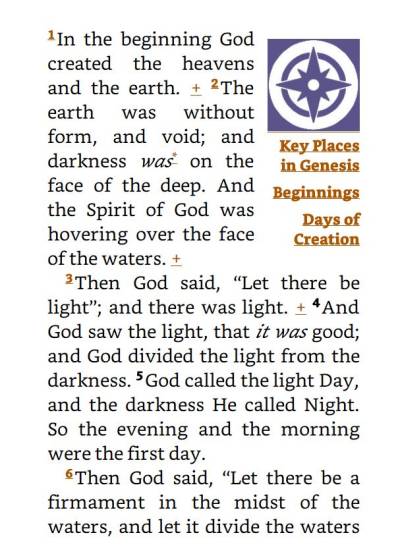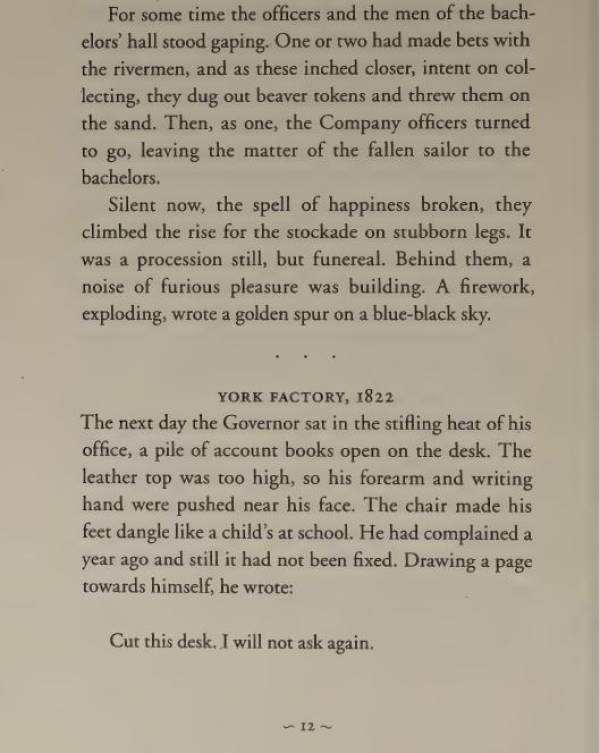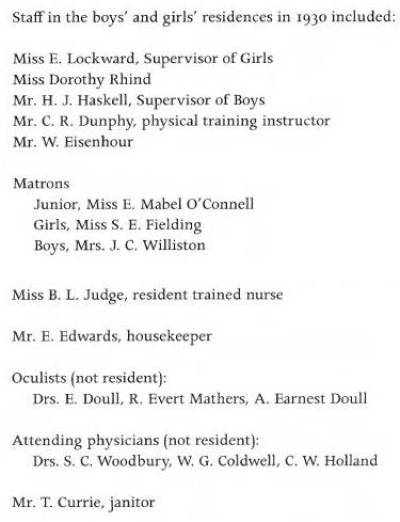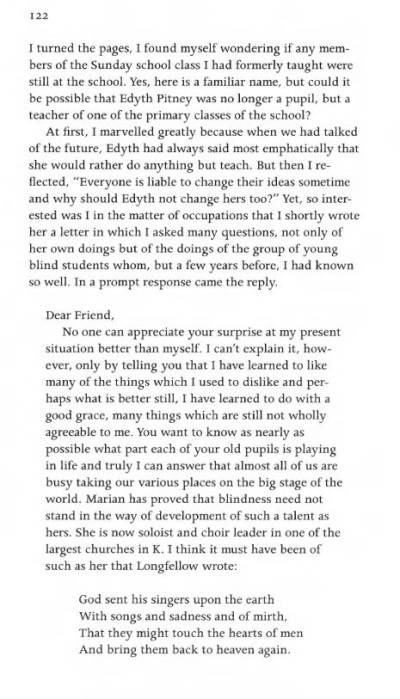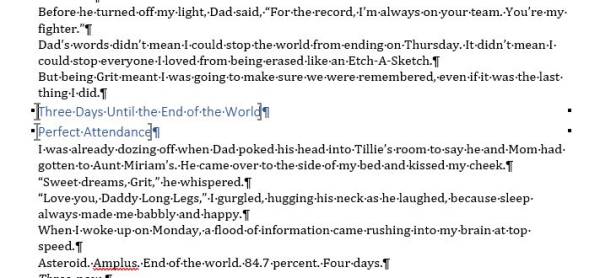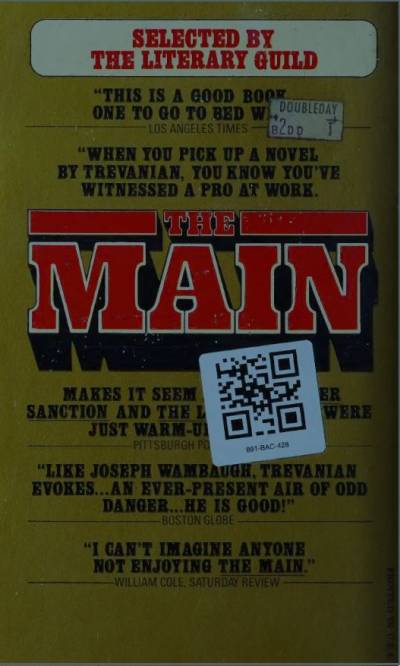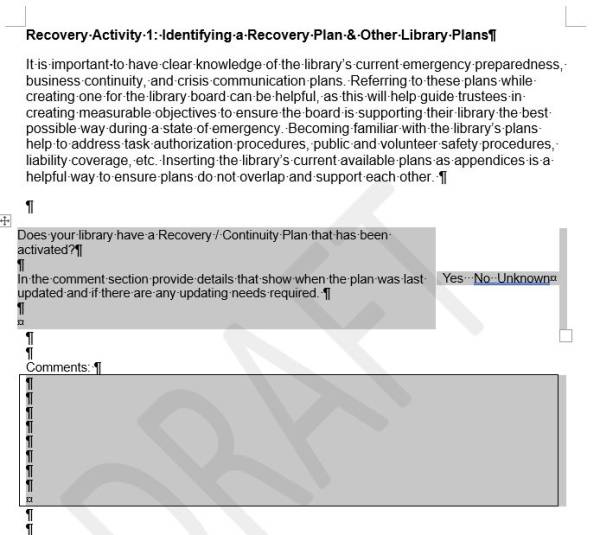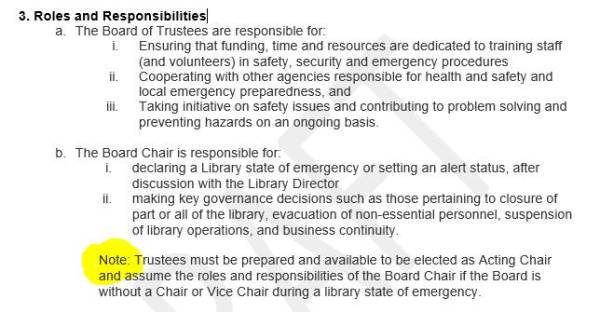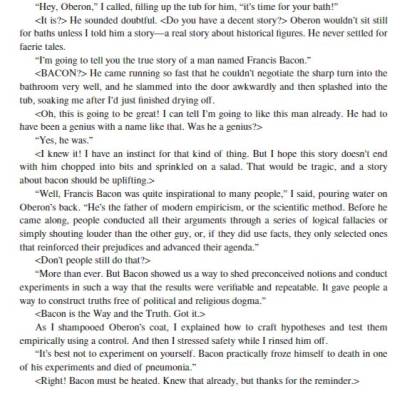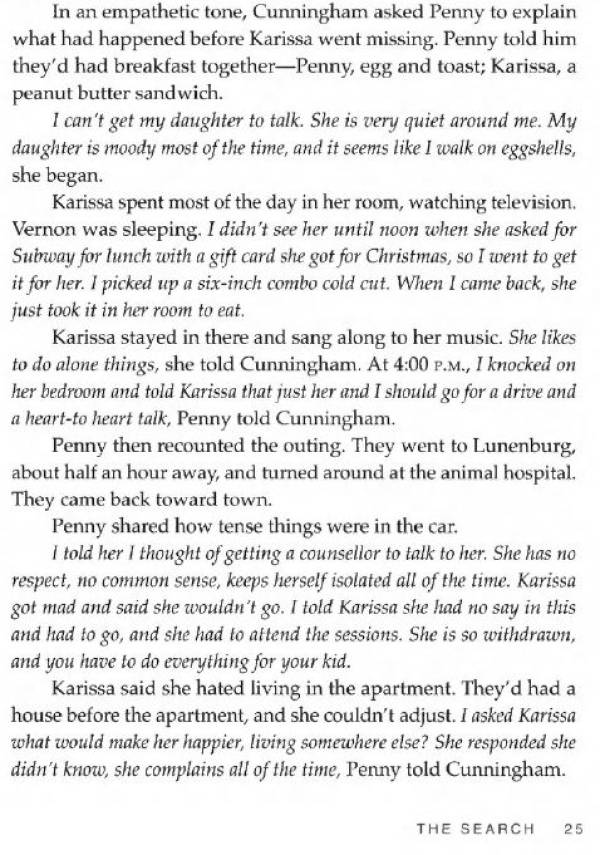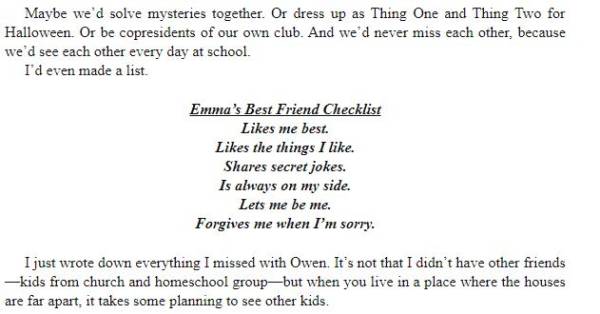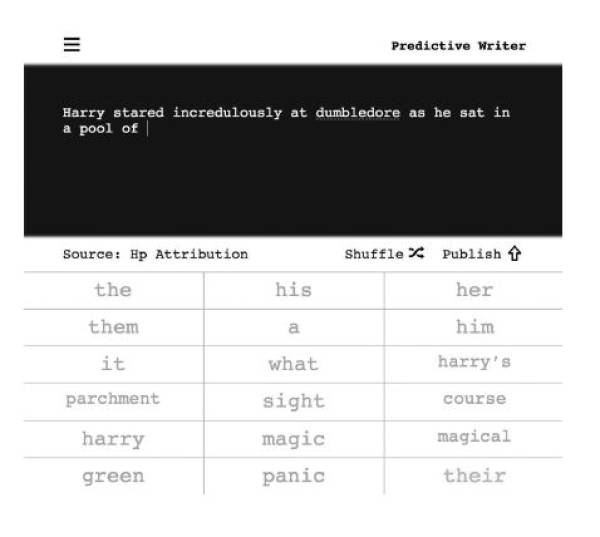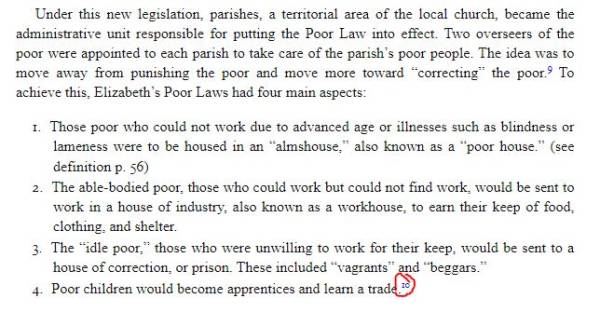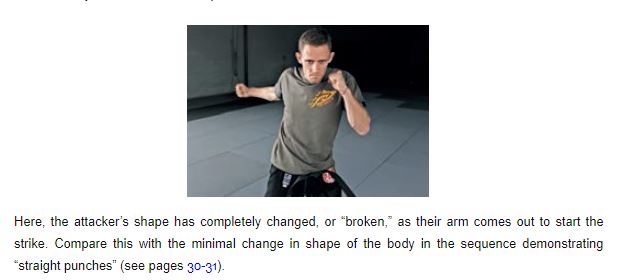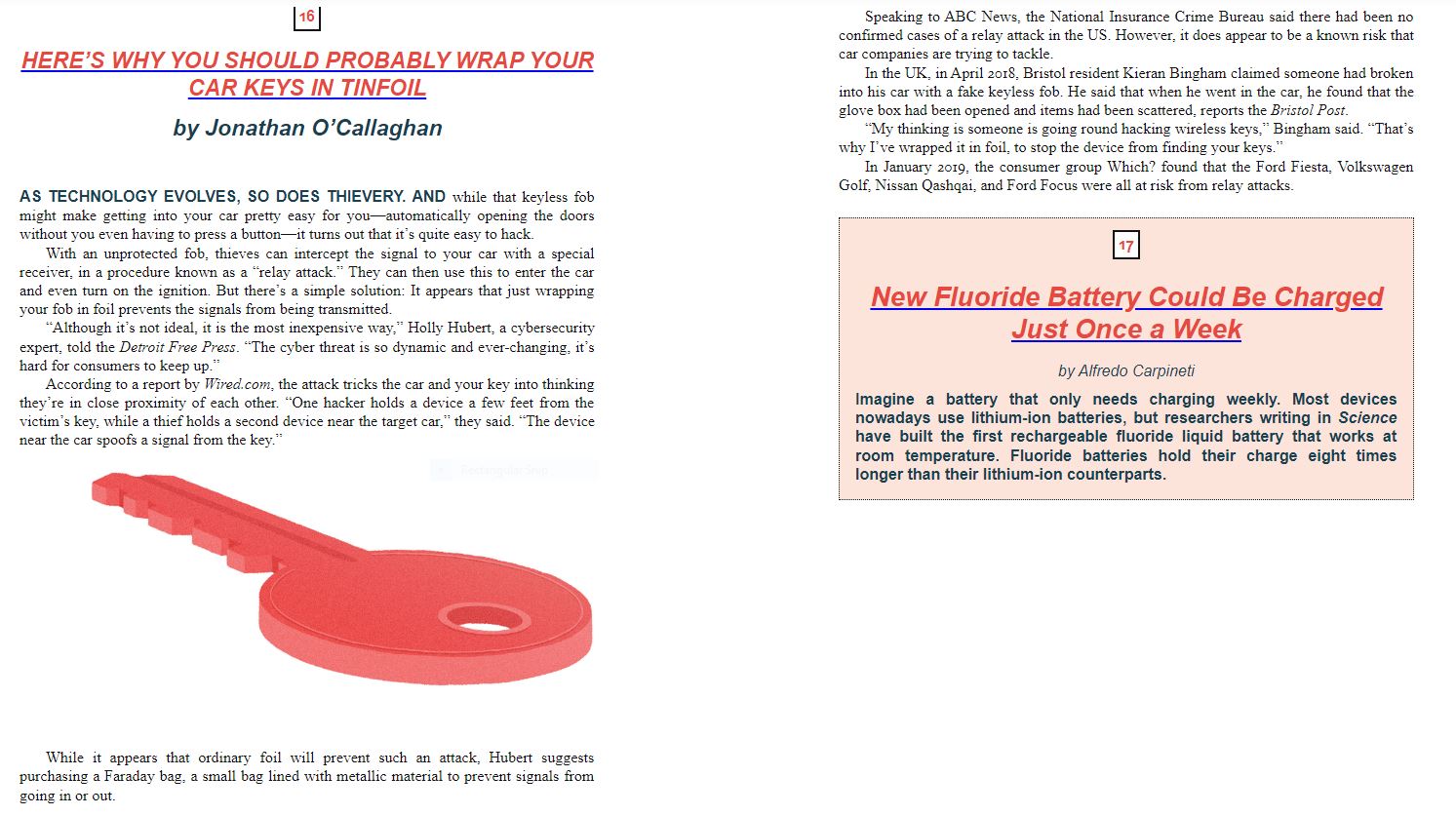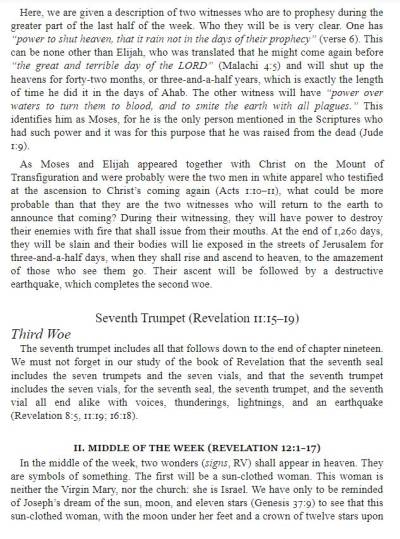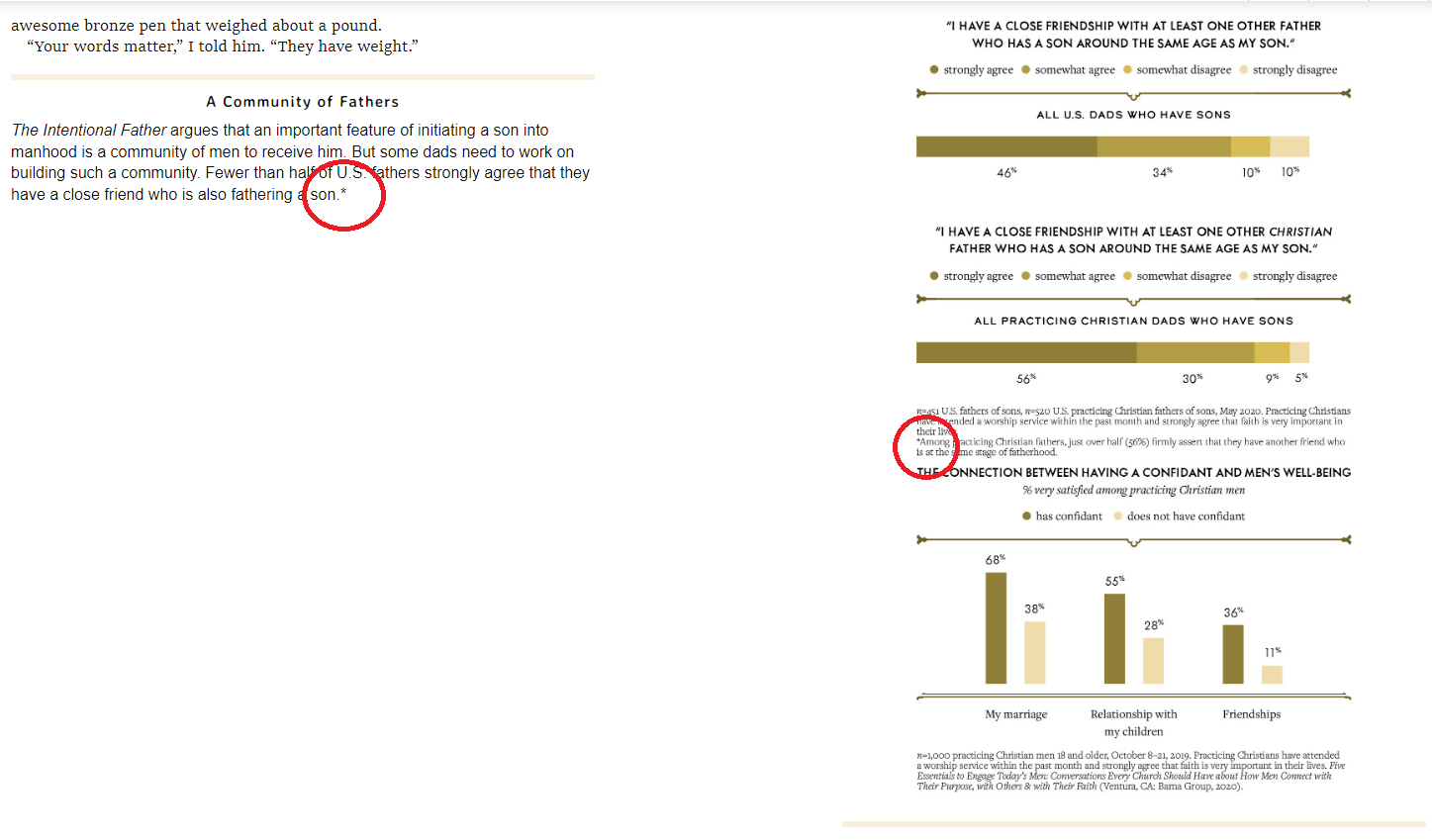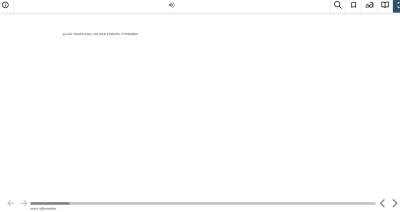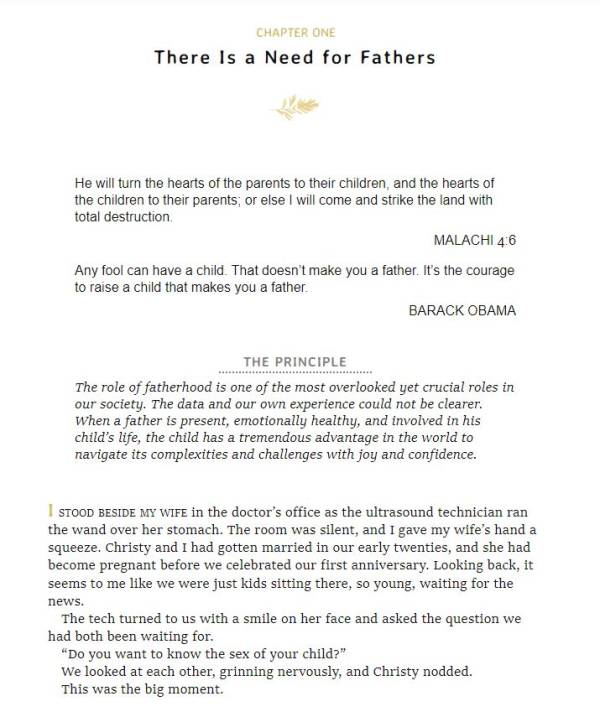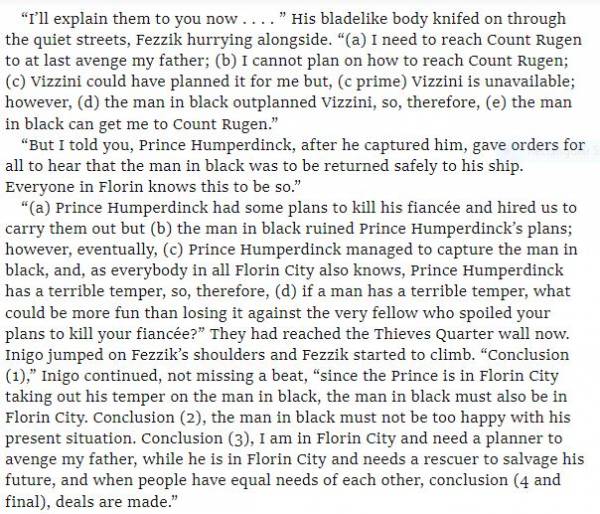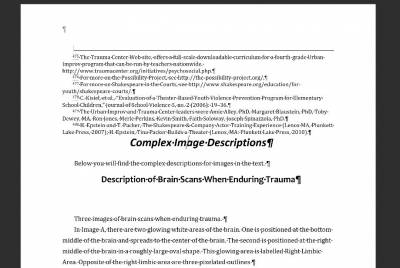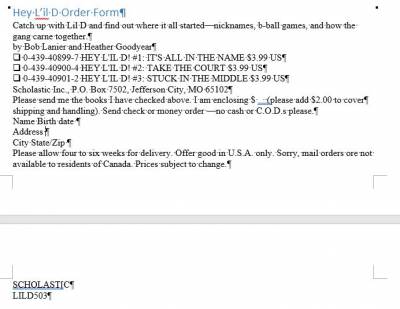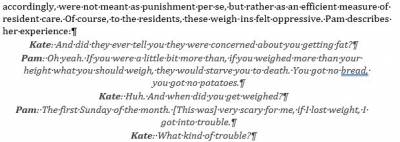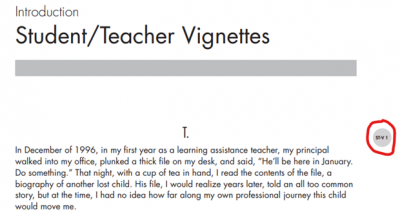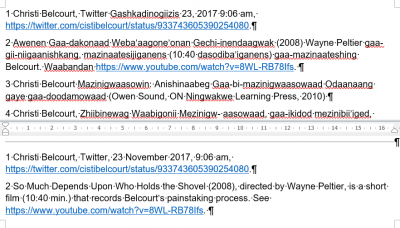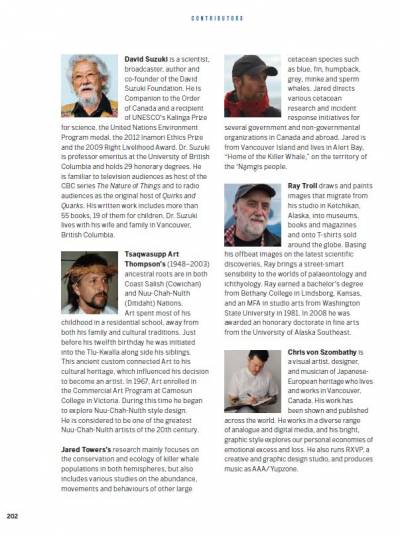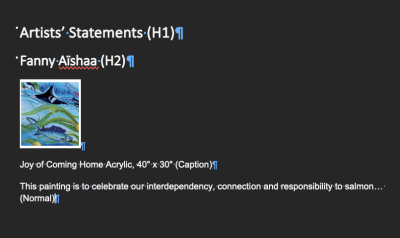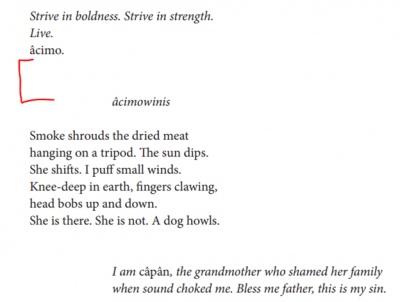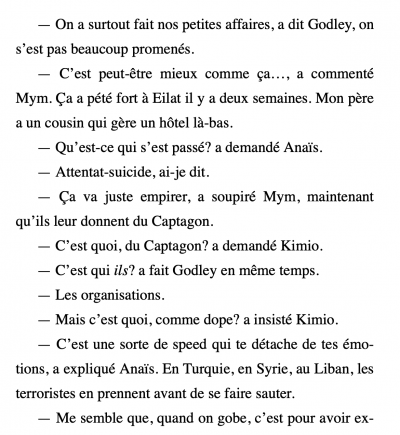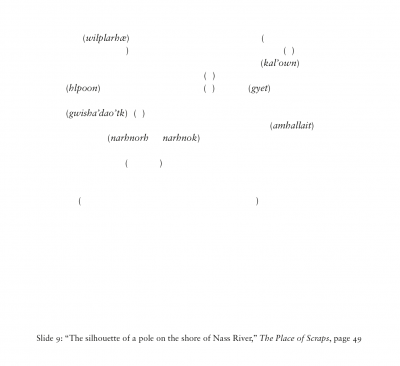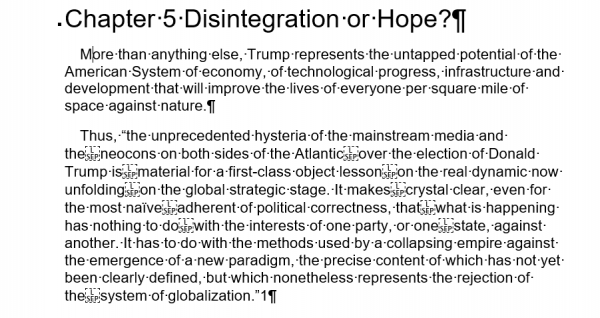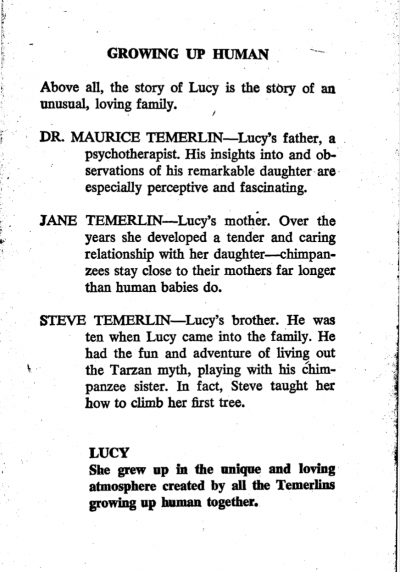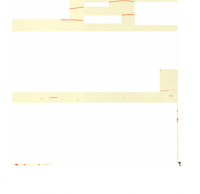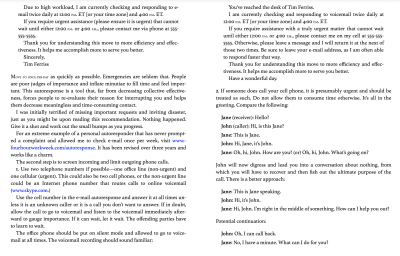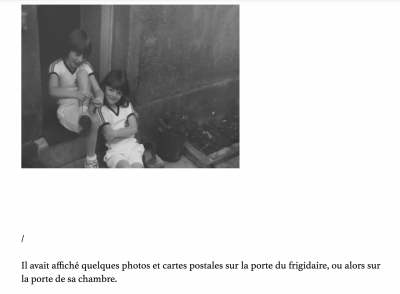Production Q & A
Post here your questions (at the top of the posted questions below) and we shall invent answers! :)
When posting a question please include:
- Title and location of issue
- Screenshot and context if applicable
Here is a video tutorial of how to post a question and image on the wiki.
Thank you for all your outstanding questions so far, and please keep posting them here.
Q: A couple of questions for Blood on the Breakwater.
1. At the very end of the book (page 229), there is a message from the author. I initially gave this the heading 'Message from the Author', but thought I should check with you.
2. Also, the section 'Kids books by Jean Paetkau:' occurs both at the end of the book (on the same page as the message from the author) and directly following the publishing information - is this okay?
Here is the screenshot for both questions: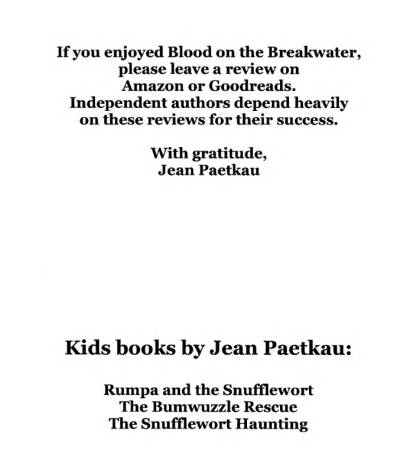
A: Remove both.
—- Q: In the BC Gov Doc “Service Delivery for Purposes of Scoping Cost and Timelines for Translation,” there is a table with an asterisk in two cells, and each asterisk leads to the same note directly below the table. Can I use an endnote or is there another way to handle notes within tables?
Here is a snip from the original, the asterisks crudely highlighted.
A: You can use an endnote.
Q: For the book Fathered by God, there are some advertisements at the very end. I have copied the image of the one that is giving me trouble. I was a little unsure how to format this and if the text at the top should be a heading, or possible a subheading of the 'Where do I go from here?' section that directly proceeds it (I had also wondered if the cover images here are decorative but from a previous question I see that they are, phew!). Thanks!

A: You can remove these advertisements.
Q: In the book Resilient: Restoring your Weary Soul in these Turbulent Times, there are short sections between two adjacent chapters. Their headings are in capital (see example). It seems that they are not the sub-headings within each chapter. Could you please suggest how to define their level of heading? Thanks.

A: These are subheadings. Style them in the correct heading hierarchy. See You can learn more about headings at Understanding and Using Headings.
Q: In the book Resilient: Restoring your Weary Soul in these Turbulent Times, there are asterisk notes in text and annotations without headings at the end of the book. Could I mark these asterisks as normal endnotes and add a heading 1 “Annotations” for these annotations?


A: We never put headings in the endnote section. You can format these into the endnotes of the document. There is documentation on this found on the Footnotes / Endnotes page.
Q: In the book Resilient: Restoring your Weary Soul in these Turbulent Times, there are short paragraphs separated by the above and bottom lines (See image below please). It seems that they are in the narrative flow. Could I put content breaks above and bottom each aside section, instead of using a textbox? Thanks!
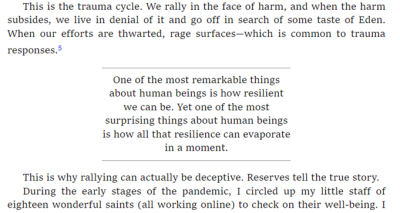
A: These are styled as textboxes in the original. Please reformat them in the Word document as textboxes.
Q: In the book Resilient: Restoring your Weary Soul in these Turbulent Times, there are many aside sections “Skill” (See attached image below). Should I use content breaks above and below each aside section? Or can I use the textbox?
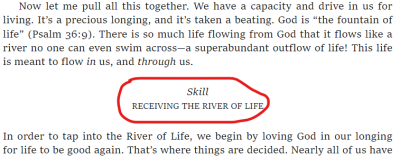
A: These are not asides, they are subsections. Format as a heading that following the heading hierarchy of the chapter. It is also a split heading, so you will have to format it as: Skills: Receiving the River of Life. You can learn more about headings at Understanding and Using Headings.
Q: In Chapter 38 of the novel Where White Horses Gallop there is a recipe (as seen in the attached image) between two paragraphs. I wasn't sure what additional formatting I should do here - at first I had put the ingredients in an unordered list but then wondered if the whole thing should be instead styled as a blockquote. Thanks!
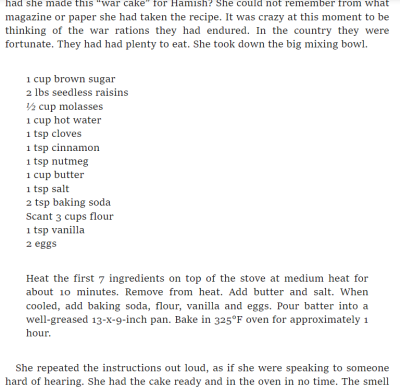
A: Format the ingredients as list, and add the phrase "List of Ingredients" before the list.We can't have complex formatting within a blockquote, but in this example the reader can still understand what is going on without the blockquote style, and that list formatting is important.
Q: It's Bouquet Not Bucket Formatting
On page 117 to 119, the author includes a section of his own proposal for an episode and it's followed by the actual episode script. I'm not sure how to format this section in particular, if it is a block quote due to the way it's introduced or I just apply Heading 2 style to "Suggestion for a Keeping Up Appearances special."
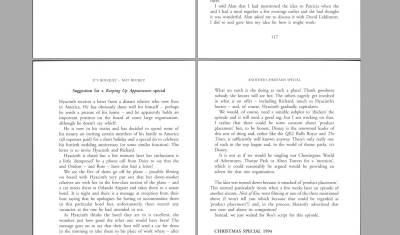 There is another example of this on page 152, where the author proposes his own version for a TV episode and follows it with what was actually aired.
There is another example of this on page 152, where the author proposes his own version for a TV episode and follows it with what was actually aired.
A: Styling as normal with the headings is good! Both versions have headings.
Q: What other types of styles/ formatting can we use with footnotes/ endnotes? In the past, I’ve used hyperlinks and strong style, maybe emphasis style. In NKJV Life Application Study Guide, there are notes with list elements. Not sure if I should format as a list or keep in the paragraph format. Here’s an example:
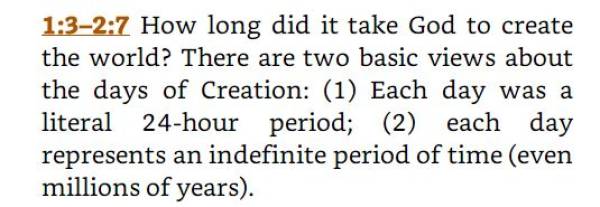
A: For the footnotes you can keep it in paragraph form.
Q: Footnotes in NKJV Life Application Study Guide
Thank you for the video about the cross-references and footnotes! Two more questions regarding the footnotes:
First, they are linked in with the verse numbers. I suppose I re-add the verse number and then add the footnote beside it? (In the example below, verses 1, 2, 3, and 6 have footnotes linked in the verse number, but 4 and 5 do not.)
Second, now that we’ve split the document into several files, how do I manage the footnotes? Can I create them for each file and then you merge them when you merge the files?
A: Yes, add the footnote beside the verse number. You can use footnotes instead of endnotes, and that will help mediate the issue with split documents.
Q: Headings in NKJV Life Application Study Guide
At the start of each Book of the Bible is a “blueprint”—basically an outline of key events—with its own hierarchical heading structure. However, this blueprint gets broken up among the Chapters of each Book. For example, Genesis.
(and so on…)
I have styled the headings in Book 25 as Chapter 25 as H2, followed by D.7 as H3, followed by E as H4. I think that's right for our purposes; however, that counters the overall structure of the blueprint, as E is a bigger topic than D. 7. I’m very confused! What do I do? This question probably doesn’t even make sense!
(This happens again in Chapter 27, and I haven’t looked further than that.)
A: It seems like you are approaching this the wrong way. The Blueprint is its own section and not a guideline for heading structure. We want to use the table of contents as a guide.
Headings must always follow a hierarchical structure from H1 to H6 without skipping any headings, otherwise it will create a false navigation. Sometimes this means the headings don't occur at the same level for every section, and this is okay.
The basic heading structure is as follows:
- Front Matter (H1)
- Any subsections in Front Matter (H2)
- Main Sections of Bible (New and Old Testaments) (H1)
- Chapters of Bible (H2)
- Any subsections (H3-5 depending on how deep they go)
The Chapters are where it gets a bit complicated. You have the Introduction with its own subsections, and then the numbered Bible Chapters with their own subsections. Rename the headings for the Introductions to Genesis: Introduction and so on.
The following is what Genesis will look like:
- Genesis: Introduction (H2)
- Vital Stats (H3)
- Subsections (H4)
- Timeline (H3)
- The Blueprint (H3)
- Subsections (headings with letters) (H4)
- Megathemes (H3)
- Subsections (H4)
- Genesis: 1 (H2)
- Subsections (H3-H4) depending on how many there are in each book. Mark in order they appear. This can vary over sections.
- Gensis: 2 (H2)
- Subsections (H3-H4) depending on how many there are in each book. Mark in order they appear. This can vary over sections.
I made you this video walking through it
Q: In The Trade, I’m not sure if my H2s are right…
I think in a previous book, phrases with location and date like in this book weren’t headings, but I don’t remember or understand why. Also, in this book, they are preceded by what appear to be content breaks of three dots, but these three dots also appear at the start of the Parts (i.e. where there is no content preceding them, so they’re not content breaks in that location) and otherwise the content breaks within the text are simply blank lines.
Here's an example. I currently have "York Factory, 1822" as an H2.
A: The three dots are Content Breaks. In this context, you can style those dates as headings, as they are: a different font and meant to stand out, and act as the heading of a new section in this context. A lot of the time, dates are just part of the content, and not headings. This one is different.
Q: In Why Does He Do That there are two sections that are similar and I’m not sure how to format… like a play? Like a list? Something else? The first is a Q&A, the second is like "If this… then this…"
A: You can format both sections like a play.
Q: In The Town That Died, there is a map that is also a two-page spread. I understand that the alt-text for both images will be with the first image and that the second image will be marked as decorative. I don’t understand how to do the Complex Image Descriptions section. Will I have 2 subsections (one for each image) or just 1 (for just the first image or both)? Now that we include the images in the Complex Image Descriptions section, I feel like both images need to be there even though they are described as one image.
A: Treat it like a single image description. You can put the link to the long desc under the first image. You can put the images side by side in the long desc section (resize them so they appear like a single image and marked both as decorative).
Q: In William Shakespeare's As You Like It, A Radical Retelling by Cliff Cardinal, there's a stage direction called "Beat" that's italicized in the original etext, as pictured below.
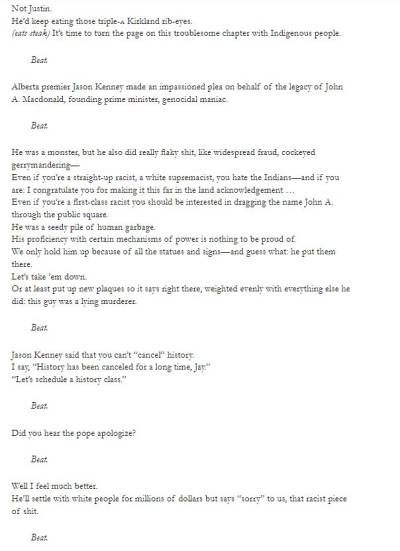 Based of the wiki page about Plays and the QnA Archive within it, I think the stage direction (eats steak) is kept normal style, but I'm not sure if I should keep the italics for the "Beat" stage direction, since it's so short and the dialogue is written like poetry or spoken word. What do you think based of this context?
Based of the wiki page about Plays and the QnA Archive within it, I think the stage direction (eats steak) is kept normal style, but I'm not sure if I should keep the italics for the "Beat" stage direction, since it's so short and the dialogue is written like poetry or spoken word. What do you think based of this context?
A: In this context you can keep the italics.
Q: In Reading Hands, there are lyrics to Christmas carols with headings for the chorus that are italicized. The word “chorus” is also repeated to indicate when the chorus is sung. How can I style this to be clear what lines are part of the chorus, and when it is sung? Or, is this like poetry where we just can’t maintain the complex formatting and so I just leave everything as Normal?
A: You can format this like a Poem. Lyrics are a form of poetry.
Q: In Readings Hands, there are lists with headings, but then additional items follow that are not part of that section. How can I show they are separate? For example, Ms. B.L. Judge and Mr. E. Edwards are not matrons, and Mr. T. Currie is not an attending physician.
A: Treat this as a single list and nest the subsections.
Q: In Reading Hands, there is a quote within a quote! How do I handle this?
A: Blockquote Inception! Format the whole thing as a single blockquote and put the inception blockquote into quotation marks.
Q: In Reading Hands, there are several lists and quotes that span several pages. The book also has page numbers. How do I insert page numbers within lists and quotes? Can I break up the lists and quotes? Can I just add the page numbers before and after (so there might be a few page numbers in a row)? In the past, I have broken up tables, but those had clear alphabetical divisions, so I made a fresh table for each letter.
A: You can break up the quotes and lists.
Q: In The Probability of Everything, there are some headings followed immediately by another heading; that is, no body text between the two headings. Comparing to the TOC, this seems right, but not sure if that’s ok for our purposes. Maybe "Perfect Attendance" and the sections following should be H3 instead of H2? Here’s an example:
A: Good question. You can treat this as a split heading. Split headings are covered on Understanding and Using Headings Wiki Page.
Q: In The Main by Trevanian, the reviews on the back cover are obscured by stickers. How do I transcribe this when I can't read all of it?
A: Include an inline producers note that the text is obscured. For example: "This book is [text obscured] a must read."
Q: In The Main by Trevanian, there are a few instances where a person’s name is replaced by a line. For example:
It’s longer than an em dash, but not a blank per se. In the word doc it is replaced by three hyphens. What should I do with this?
A: Remove the dashes and keep the letter only. It retains its meaning without having accessibility issues.
Q: The Sources (Bibliography) section of Dans l’ombre du soleil lists a number of sources in English. In some of them, there are names that we wouldn’t normally mark up and also numbers that could easily be pronounced by TTS in French. However, I wonder if it’s jarring for parts of a title to be marked up and other parts not. Here’s an example:
« Afronauts : Interview with Edward Nkoloso, Head of Zambia’s Unofficial Space Program, Nov. 1964 »
Should I mark up “Edward Nkoloso”? “Zambia”? 1964?
A: We never mark up proper nouns: names, places and titles. This is covered on the Languages page
Q: In Dans l'ombre du soleil, between the cover and other books by the author is a page with just this in the centre:
Les Éditions du Boréal / 4447, rue Saint-Denis / Montréal (Québec) H2J 2L2 / www.editionsboreal.qc.ca
(I used slashes to indicate line breaks here in the wiki because it was just showing up as one line.)
There is a full Publishing Information section as well, so this isn't that. What should I call this section?
A: Is there a title page? This looks like an incomplete title page? If there is a title page, move it to the bottom of the title page. If there is no title page, move it to the top of the Publishing Info.
Q: I'm just having trouble deciding if this should be styled as a quote or as a list (since I can't do both with a quote!). What do you think? If a list, I think I need a heading?
A: Good question! As there are phrases before and after that are part of the quote, we can format it all as a quote.
Q: Galumpf by Marie Hélène Poitras uses « and » as quotation marks. I know this is common in French, but just want to make sure they’re ok for our purposes.
Also, there are spaces on the insides of these quotation marks. Is it ok to keep these? When I remove them, the quotation and word next to it becomes underlined like a grammar issue, so maybe French readers need this space. I saw a similar Q&A about spaces before punctuation (theirs had no dots to even indicate a space was used, whereas mine does), and you said you’d like a sample to check out on your end. Would you like me to do the same?
A: Great question! That is the way French does quotations. Leave as is!
Q: Dialogue in Tricked by Kevin Hearne
I'm doing revisions for telepathic dialogue, and I came across this section of dialogue in the included Two Ravens and One Crow novella. The top photo is from the original etext, and the bottom photo is with revisions applied.

 Because there's three speakers talking, and Atticus is speaking outloud and telepathically, I found the revised version hard to tell who is speaking. It makes it seem like "To hide the evidence of his blistering passion—" is said by Atticus when it's telepathically said by Oberon. What do you suggest about how to handle this section?
Because there's three speakers talking, and Atticus is speaking outloud and telepathically, I found the revised version hard to tell who is speaking. It makes it seem like "To hide the evidence of his blistering passion—" is said by Atticus when it's telepathically said by Oberon. What do you suggest about how to handle this section?
A: Format it as advised. We have to be consistent with our formatting. We are not editors, so we can only work with what we have within accessibility guidelines.
Q: I’m just not sure what to do with this section of the Kootenay Library Association document titled “Emergency Preparedness and Recovery Plan Template”! In the original Recovery Activity #1, there are two textboxes, one atop the other. (I've highlighted them in grey in the first screenshot. The first box didn't have a border, so it was hard to see.) In my document, I’ve condensed them into one text box because I feel that is the point of the section, but wonder if headings are needed or if this is even the correct approach at all! What do you suggest?
Here is my current attempt (spans two pages):

A: The first part is a textbox. The comments is a separate form. Format as Comments: with several underlines. (Note: This is not something we would do for regular eText production, just for this one particular case as I will be converting it to a PDF for the client, do not do this for any other book you work on without asking first.)
Q: For the Kootenay Library Association document titled "draft Emergency Preparedness & Management template policy," I’m not sure what to do with a note in the section 3B. It relates to the whole subsection, and not just the prior point, so I’m hesitant to stick an endnote reference to the end of the point.
(Also, I’ve chosen to use subheadings for the phrases like “The Board Chair is responsible for:” instead of keeping them as the first level of the list as in the original…)
A: Keep the list structure. Put the note in a textbox and have the phrase "Note" as a subheading.
Q: URLs in Best Barbarian Poems
In the Notes Section of Best Barbarian Poems, there are some URLs but they're not hyperlinked. The screenshot below is from the EPUB. I checked them and their pages work properly, but I know we don't insert hyperlinks if they're not originally there. Do I leave the URLs as is then?

A: See Hyperlinks Wiki Page for answer on broken links.
Q: In Hexed by Kevin Hearne there is a quote of a four-line Polish chant. Since quotes can't be used with another style, I guess I have to choose quote or language styling. Which should I choose? Or is there another way around this?
A: You should be able to add a language tag to this. If you are unable to, please just make a note of where the quote is when you hand back the title in RT.
Q: Another Dialogue Formatting Question for Tricked by Kevin Hearne
Just to double check, I found another instance where the author used special formatting for a specific dialogue type. In this case they used double / instead of quotation marks, as shown in the image below.
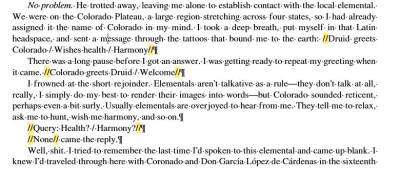
Would this also be treated the same as how we're formatting the dialogue with < and >? Just replace with quotation marks and remove the / between the sentences?
A: You are correct. A good question to ask yourself is what are these markings being used for? In this case they are being used for dialogue. Can the reader still understand the meaning of the dialogue when we replace these markings with quotation marks?
These marking are only for visual meaning, so they are in accessible, so we have to replace them with something that is accessible.
If the words and phrases are thoughts, we replace them with emphasis style.
If the words and phrases are dialogue (even telepathic dialogue), we replace them with quotation marks.
In the examples you have shown here, they all seem to be dialogue of some sort.
Q:
In Hounded (and possibly also Tricked, as this question relates to the previous question), I have been using emphasis for the dialogue in angle brackets and keeping the emphasis on the telepathic speech. At first, these were short exchanges (like in the previous question) between a person and their dog. But the further along I get in the book, the longer these conversations get and I wonder about their clarity for the reader. What do you think?
Here is an example passage in the original epub:
Here's the same passage in my word doc with all the emphasis:
In Tricked by Kevin Hearne
I'm a little uncertain about this section of text on how to handle emphasis. This example is in Chapter 5, but there's a couple similar instances of it throughout the book.
 From the context, I think the character is saying "I miss Fragarach" out loud, and the text in emphasis is what they say to Oberon telepathically. <Easy> I think is what Oberon says telepathically too since Oberon is a wolfhound. My thinking is to keep whatever text is emphasized and change <Easy> to emphasis as well, would this be correct?
From the context, I think the character is saying "I miss Fragarach" out loud, and the text in emphasis is what they say to Oberon telepathically. <Easy> I think is what Oberon says telepathically too since Oberon is a wolfhound. My thinking is to keep whatever text is emphasized and change <Easy> to emphasis as well, would this be correct?
For Formatting Dialogue in Tricked
In Tricked by Kevin Hearne, the original etext formats dialogue from one specific character using < or > symbols, as pictured below:
My instinct is this is a stylistic choice, but I'm not sure how to handle it. Should I leave it as is, or replace it with quotation marks?
A: Original Answer: Looks like it is thoughts. Replace them with emphasis style.
Updated Answer: You are right to have a concern with this, especially when there is a mix of thoughts in emphasis and these bracketed phrases. Since these brackets are for dialog, replacing the brackets with quotations marks with make it clearer to the reader and avoid confusion between thoughts and spoken dialogue (even if it is telepathic speaking).
Q: In Hounded by Kevin Hearne, there is section for pronunciation of names and words used in the book. This guide uses capitals to show which syllables are stressed. Since we only retain capital when something is meant to be spelled out, is there another way I can format these that doesn't use capitals? Here's an example:
Tuatha Dé Danann = Too AH day DAN an
A: In this case keep the capitals as they appear in the original.
Q: Formatting transcriptions of poems and letters in alt-text, in Taxi: The Harry Chapin Story.
There is an image of a piece of paper with a typewritten poem and handwritten letter. For the poem, should the transcription be formatted as normal with the title as a subheading, or preceded by "text reads" and styled with quote and citation styles? (Currently I have the title in the summary sentence.) For the letter, in the past I have transcribed letters as a paragraph within quotations. Now I wonder if quote style might also be appropriate for letters.
A: Transcribe both sets of text as per the Images With Text Wiki Guidelines
Q: I noticed a couple uses of italics in the EPUB/PDF of Billie's Blues, but when I search the word doc for italics or emphasis there are no results found. How do you recommend I search for italics now? Just skim the text?
A: Yes, you will need to skim the book if the search is not working.
Q: In Billie's Blues, there are two sections near the end of the book with long tables, and the page numbers continue through them. The second table should be split into multiple shorter tables (it is providing information by year), so I think I can fit the page numbers around them. But I don't see how to split the first table, which means the page numbers will interrupt the data. What should I do?
Update for new thoughts: Nothing in the tables is referenced in the index, so maybe I can skip the page numbers for the tables? Or, divide this first table by letter since it's in alphabetical order?
First of four pages of first table:
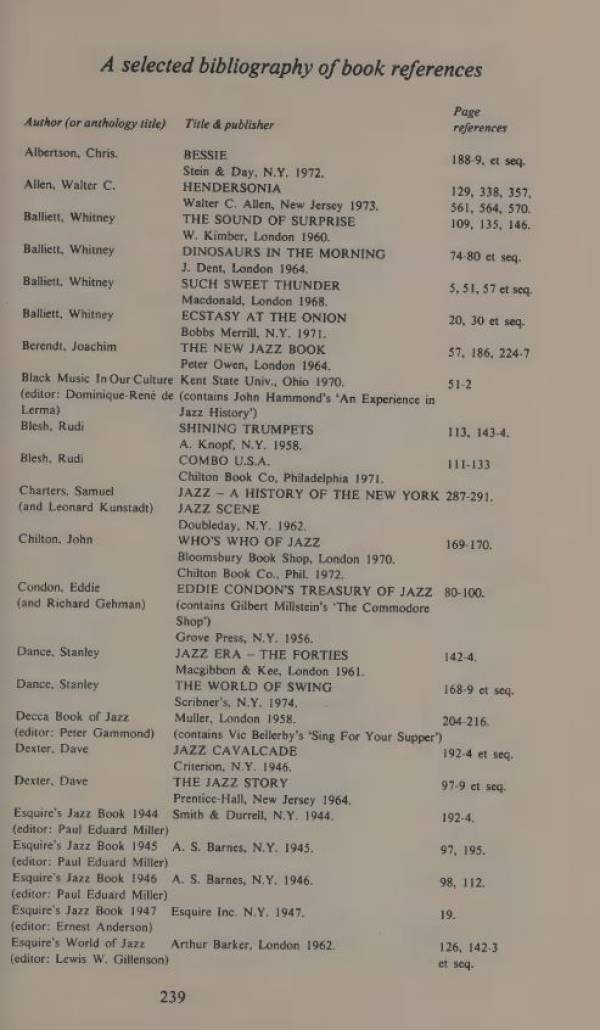
A: Keep the page numbers and split the data into separate tables. If the data at the end of one page crosses over to a second page, simply move the data to the first page table.
Q: URLs that aren't hyperlinked in Mommy Don't
The endnotes for Mommy Don't are full of URLs that are not hyperlinked in the original PDF. Since they aren't hyperlinked in the PDF, I understand I don't hyperlink the eText. But should I still shorten the URLs so they are more screenreader-friendly? If the URLs aren't hyperlinked and they are shortened, then readers won't be able to search for the website themselves.
A: Add the links to the DOC file and shorten them. This way they go to the right place.
Q: In Mommy Don’t, there is this portion of an interview in paragraphs where some lines are normal and other lines are in italics, as though the interviewee said some things in the paragraph but not others. Should I follow the text and use Emphasis where the interviewee is speaking? Some paragraphs clearly indicate that the interviewee is speaking (like paragraph 2 in this example: “… she began.”), so I wouldn’t use Emphasis, but I wonder if that inconsistency between the paragraphs will be confusing.
A: This are the person talking, and the italics are just there for style. Remove the italics and put quotation marks around the phrases.
Q: In Because of the Rabbit, there are a number of block quotes with lists! I understand that if we style something as a quote, then we can’t use another style. But I wonder if we might ever choose one style over another. Here is an example:
One of the block quotes with a list also includes crossed out items. Is this a case when I can keep the strikethrough formatting? Here it is:
A: Great question! Since the first example is a list, it would be better to format it as a list. In this case it is a list with a title, so you would style the title as a subheading. For you second example, this is a bit more complex. We can not keep strikethrough as it is not accessible to screenreaders. Replace the text with: [Strikethrough “word/phrase” replaced with “word/phrase”].
Q: In the Supplementary Material for You Look Like a Thing and I Love You, there is this image of a fake screenshot from a fake app called Predictive Writer. At the bottom of the image is a table that has no headers and the words are pretty random (i.e. each column is not a particular part of speech). I will be recreating this table in my long description, but I'm not sure what to do about the lack of headers. Should I create a header row and just call these Column 1, Column 2, Column 3? Or something else?
A: That is a great solution for a header row! It is plain, direct, and concise.
Q: In A Wholesome Horror, there are a few lists that are followed by a reference to an end note. Presumably the note refers to the full list, not just the last item. Does this note force the list to be an ordered list, even if it would be unordered without it? Here's an example:
A: No. We want to keep it as close to the original as possible, so keep the list as it appears in the original and add the note to the same place it appears in the original as well.
Q: Hyperlinks within captions in Krav Maga
In a few of the image captions in Krav Maga, there are also hyperlinks to other pages within the book. And the hyperlinks display as page numbers but there are no page numbers in the EPUB. How do I handle this? Here’s an example (it's a bit hard to see, but the hyperlinked portion is the numbers "30-31"):
A: In this case, remove the hyperlink, and replace with the book section header. For example: (see section "Lead Hand Punches and Rear Crosses")
Q: Table of Cost of Living in Teaching Kids to Buy Stocks
In Chapter 6 of Teaching Kids to Buy Stocks, there is a table that lists the cost of living in 1952. I had a few questions.
 1. There isn't a heading row for this table, but I think it should be "Item" and "Cost." Can I add an extra row for this?
1. There isn't a heading row for this table, but I think it should be "Item" and "Cost." Can I add an extra row for this?
2. There's a subsection of the table that lists costs of food. My instinct is to split the table into two, but I'm not sure.
A: Yes to both questions!
Q: What do I do with hyperlinks that are in the ebook but I have removed the section they refer to from the word doc? For example, in 117 Things You Should F*#king Know About the World:
1. The section headings in the ebook are linked to the TOC, but I remove the TOC from the word doc. I feel like I can ignore these without consequence.
2. Most of the art credits link to images that I consider decorative images, which should be removed. However, without a link, the text has less meaning as they rely on the link to show which image is being referred to.
Here's what the Art Credits section looks like:
Here’s an example of two images that are linked in the Art Credits section. Images like these precede every chapter.
A: Remove the links from the headings. Do not remove these images as they add meaning to the text (they are credited and add extra visual meaning to each section).
Q: Some of the articles in 117 Things You Should F*#king Know About the World are in coloured text boxes. However, I’m inclined to not consider them asides– each article is numbered, including those in the text boxes, and they are all in numerical order. I think the text boxes are just helping to visually differentiate the articles. What do you think?
Here's an example one article (#16) not in a text box followed by one that is (#17).
A: You are correct, these are not asides. If you go to the TOC in Thorium you can also clearly see they are their own sections at the same heading level. Good call!
Q: A few chapters in Dispensational Truth end in poems. Should I style them as poetry (headings with body text as normal) or as quotes (because they're set off from the other text and centre-aligned)? Here is one example. It is the only one that is preceded by a content break.
A: You can format these as poems.
Q: Is this a list? In Dispensational Truth. (It reminds me of one from The Intentional Father…)
A: This is not a list. It is not a series of grouped items/phrases, but short paragraphs. In 'The Intentional Father' those where grouped phrases (i.e. a series or related questions in a row.)
Q: In chapter 23 of the EPUB version of Dispensational Truth, the headings get out of hierarchical order. I understand that we don’t edit books, but I also understand that we want to make the books accessible. I found a similar Q in the Q&A for the book The Good Turn, but I got lost in it… Here is a screenshot of my current navigational structure according to what I see in the book and two screenshots of pages from the book. I think that “Middle of the Week” and “Last Half of the Week” should be H3 to match "First half of the week", but in the EPUB they look like H2.
A: We reformat books to be accessible, part of that is creating proper headings and heading hierarchy. Always follow the rule of hierarchy no matter what the original does.
Q: Two columns or lists in Dispensational Truth.
There are three tables in the EPUB titled Dispensational Truth. All three are really just two lists side by side for comparison purposes. I’m not clear on whether these should be formatted using columns or lists. The section in the wiki on tables seems to say to use columns, but then it says that columns are rarely used so I should check with you. Here is one example:
A: This is a proper table, with a heading row and the data below it.
Q: Individual dedications in The Jaguar
In the poetry book The Jaguar, there is a book dedication at the beginning, but some poems have their own dedications. I posted two poems as examples, and I'm wondering if I should apply special styling to the "For E." and "For Vera Pavlova" to indicate they're dedications.


A: You can keep them as they appear. It is self explanatory from reading the text what they are.
Q: This question is mostly answered in another Q&A for the book Qaqavii, but I have another layer to it… In The Intentional Father, there are two sections that have lists with multiple paragraphs in some of the list items. The solution for the first Q&A question was to use strong style instead of the list or headings, as that's what was in the eText. My original eText formats these parts with a heading that is bold and italic, so I'm not sure which I would use. Here is one page as an example:
A: This book is pushing you to the limits! In this case, stick with bold as it is a standard formatting for plays and Q&A's. We want to avoid italics as much as possible whenever we can.
Q: Endnote within an image within an aside… in The Intentional Father.
This aside begins with the heading "A Community of Fathers." There is some short introductory text then an image of graphs with more text. At the end of the introductory text is an asterisk representing a note. This asterisk responds to another inside the image. Where do I acknowledge the note? As a normal endnote, or with the image alt-text?
Here it is. The left page begins with a bit of the book's body text, then there's a break for the aside. The right page is one image file. (Also, looking at these pages without the full context of the book, they look like they could be content breaks. But I'm pretty sure they are secondary content because 1. other content breaks throughout the book are blank lines and 2. the body text on either side of these pages flows together.)
A: You reformat the not as a regular endnote.
Q part 2: It looks like I don't have the option to format as a regular note–the insert endnote button is greyed out. Now what?
A: This sounds like a file issue. I will email you to set up a quick one on one to trouble shoot what is going on.
Q: Styling for Time Period Page in Sisters of the Wolf
In Sisters of the Wolf, there's one page that just describes the time period the story takes place. This time period is for the entirety of the story, so I don't think it's considered a Part section. I'm not sure if I should apply Heading 1 style to it or just leave it as is. Here's what it looks like in the unedited Word doc (the right page):

A: Could you tell me where in the book this occurs, or upload a screenshot of how it appears in the original. I need to know the context in the original epub, otherwise I can not answer the question. Thanks!
Q: Sorry about that, it occurs at the beginning of the book, right after a section that lists the cast of characters. The text I'm uncertain about how to style is the "40,000 YEARS AGO, ICE AGE EUROPE, PYRENEES". Right after this page is the Table of Contents, and then Chapter 1. The image I posted is from the original Word doc, but this is how it looks like in the epub.
A: Thanks. You can style it as normal text and add the heading Time Period to make it a bit more clear to the user.
Q: Each chapter of The Intentional Father ends with two sidebars: Questions to Think About and Intentional Steps. In the first few chapters they were short with simple lists. As the book progresses, the Intentional Steps sections are becoming quite long… some include images, some include tables, and as text box they are often not fitting on one page. I wonder if I should turn them into subsections instead? (A quick amendment: I did see the Q&A in the Textboxes section of the wiki that we can include things like images in a text box and that there are workarounds for extra large textboxes, and so I formatted the first couple complex ones that way. But when it's the norm rather than the exception, I wonder if there's a better, simpler, clearer way.)
Early sidebar example:
Later sidebar example (pages 1 and 2 of 3):
A: These are textboxes, so we should treat them as such. You don't have to apply the textbox in the word doc, simply add the term aside at the end of each heading and I will insert the code when I convert it to create the textboxes in the accessible EPUB version. (Answer to amendment: these are still textboxes and secondary content within the original book, so we treat them as such. You can use the heading method of adding the word aside, and it is very easy for me to fix it in post!)
Q: Each chapter of The Intentional Father begins with quotes and then “The Principle,” which kind of acts like an introduction. How do I set off “The Principle” sections from the rest of the text? They look text box-ish, but they’re not secondary content. I’m thinking a heading or a content break, or both I suppose. Here's what it looks like:
A: A heading and content breaks would create false navigation. These do appear to be asides, so apply text boxes to them.
Q: List of quotes in The Body Keeps the Score
In the original etext, there is an unordered list of quotes from patients. Should I keep it as an unordered list like the original, or should I apply Quote style even if it loses the unordered list format?

A: format them as thier on quotes (i.e. highlight the first quote; apply Quote Style. Highlight the second quote; apply Quote Style) this will ensure that each quote is wrapped in its own quote tag.
Q: Three more questions about lists in The Princess Bride.
First, in this section, if I change the numbered items to a list, it will read like 1. 2. 1. 2. Will that be confusing?
Second, in this section, the letters directly follow quotation marks within speech. When I apply the list formatting, the letter directly precedes the quotation mark. Is that ok?
Also in this second section, narrative is combined with the first point. That is, the list begins in the first part of the speech, is interrupted by the narrative, then continues on within the speech. How do I format this? Here’s what I tried.
A: They really love listing things in this book! The more I look at this, the more it seems like we should not use the list style for some of these instances where is causes more confusion for the reader. A good rule of thumb is: can the meaning be gleamed from reading the text without applying the list style? In this book, it seems to cause more of a barrier than and access. You will need to use your judgement on when it is a barrier or an access. For example, your instinct on the first one is correct! It will cause more confusion apply a list style.
Q: Tables in The Body Keeps the Score
Just for clarification as I'm working on the table I posted earlier for The Body Keeps the Score, do I put the reformated table under the image of the table? Or should I remove the image? And if I keep the image of the table, should I add a brief alt-text to it to refer to the reformated table?
Also, since I'm writing a Complex Long Description, and now we're adding images at the beginning of each long description, should I insert the image of the table? Or a copy of the reformated table?
A: Treat it like any long description. Table goes into the Long Description only.
Q: In fiction, do we style numbered items as Ordered Lists when they are part of a sentence? Here is an example from The Princess Bride:

A: Yup!
Q:Table in The Body Keeps the Score
This book has an image of a table that catergorizes types of brainwave activity. I'm aware I need to recreate the table using the tools in Word, and I was wondering what should I do for the small graphs in the third row. Should I cut them individually and reinsert back into the Word table? I'm also not sure how to handle the alt-text for the graphs. Should I add alt-text to each graph individually? Or just keep everything together in the table description, or make a long description. I'm thinking I might need to do all three methods, do you have any suggestions?

A:You will want to do a long description for this one. Instead of having an image of the wave length, replace it with plain language (i.e. a simple sentence describing the wavelength)
Q: Endnotes and Headings for The Body Keeps the Score.
I inserted the endnotes at the end of the book, and I'm adding in the Complex Image Descriptions and Terms of Use after it. However, I noticed that none of the Headings I add after the endnotes show up in the Heading navigation panel. I think because the endnote settings are set to be "End of document", it kind of messes with any of the sections added afterwards. However, I'm able to create links and bookmarks for the complex images just fine. Is there something I can do about the headings not showing in the Navigation panel? Or should I just leave as is?
A: Endnote always go at the end of the book, so *after* the Complex Image Descriptions and Terms of Use. Also, you can not have headings in Endnotes, so that is why you are having those issues. This is answered in the Q&A Archive on the Footnotes & Endnotes page, but I will copy the answer here: We do not divide the Endnotes under headers, and we use continuous numbers, and do not repeat numbers. We reinsert all the notes as Endnotes with continuous numbers despite what it looked like in the original. Those headings are not make the notes more accessible. You only need a linked note to be accessible, so we remove the headings. There is an Advanced Tip area that shows you how to track endnotes that repeat numbers in the original ebook.
Q: Continuation of Endnote question.
Thanks for the quick reply. To elaborate, I didn't put any headings for the endnotes, and I did put the endnotes before the Complex Image Descriptions and Terms of Use. I added some screenshots to hopefully show more of the issue. In the screenshot, "Complex Image Description" is in Heading 1 style, and "Description of Brain Scans When Enduring Trauma" is in Heading 2 style. In the Navigation Pane, these headings don't show up for me. The Index section is before the endnotes.
A: Endnotes go at the end of a document, anything in the endnotes section becomes formatted as part of that section. Headings, normal text, becomes inaccessible in the endnotes section. Never put anything after the endnotes. I miss wrote my previous answer (which I just amended): Endnote always go at the end of the book, so *after* the Complex Image Descriptions and Terms of Use. Let me know if you need more guidance or clarification on this.
Q: At the back of The Case of the Rainy Day Mystery, there is an order form for books in another series. Is this something we keep? If I keep it, how do I handle the blank spaces where someone is to write their personal information? Here is the ad, followed by the transcription that was in the word doc provided to us (spanning two pages).
A: You can delete this.
Q: Are these really blockquotes? In The Case of the Rainy Day Mystery.
These lines are set off from the regular text as a blockquote would be, but unlike a blockquote they are very short! Should I style as quotes?
Example 1, the narrator writing in his journal (split onto two pages):

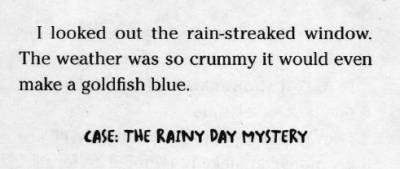
A: Yes they are! The intent of the publisher it to have them stand out as quotes, so we apply quote style.
Q: Caption Style in The Body Keeps the Score.
One of the captions for a photo in The Body Keeps the Score is a quote from Charles Darwin. Should I just leave it as Caption style, or should I also add Quote Style and Citation Style on it as well?
A: Caption style only
Q: An addition to the previous question about the book The Seeds of Change. I presume that the titles presented in these sections should be in unordered lists (one list per section), but how do I include the author, summaries, and websites? Do they end up being a second level in the list? Would this be better presented with headings?
A: This would be better presented as subheadings.
Q: Images of book covers not on the cover. Book: The Seeds of Change.
There are two sections near the end of this book that advertise other books by the author and publisher. They include a cover image, summary, title, and author. These sections are provided as images. I understand I am to remove the full image and transcribe the text within in, but what do I do with the cover images within the larger image? On the Cover Image Description page of the Alt-text section of the wiki, I found a link to a video about this, but “that content doesn’t live here anymore.” Instructions prior to the link for this video say to remove the image and replace with title of book. Just want to make sure I’m not missing any extra information that was in the video.
Here is the image of one of the sections:
A: Transcribe the section and remove the images of the covers as they are decorative in this situation.
Q: Blockquote styling. Book: Institutional Violence and Disability
The section on the wiki about blockquotes says: "Quote style can only exist on its own." In feedback for my work on this book, you clarified that a section I styled as an interview should actually be a quote. In the accompanying video, you showed me how it should look. I noticed that you kept the bold styling for the people's names, but I'm not sure if that was because it was ok to leave it or because you just weren't focusing on that part. Would you please clarify if I need to remove the bold styling? To refresh your memory, here's what it looks like now with both:
A: My apologies, you are correct. Remove the strong style.
Q: Meaningful display text for hyperlinks in bibliographies. Book: Institutional Violence and Disability.
The bibliography of this book includes many websites. Since references are supposed to be in a very specific format, I'm hesitant to change it too dramatically and am unsure how to update the display text. Here's an example:
Alamenciak, T. (2014) Remembering the dead at Huronia Regional Centre. The Toronto Star, December 29. Retrieved from http://www.thestar.com [wiki is linking automatically for me]
Thought 1: Shortening web address.
…Retrieved from thestar.com [hyperlinked]
Thought 2: Finding the address for the specific article, and then using the article name as the display text. This is redundant but keeps the reference structure.
Alamenciak, T. (2014) Remembering the dead at Huronia Regional Centre. The Toronto Star, December 29. Retrieved from Remembering the dead at Huronia Regional Centre [hyperlinked]
Thought 3: Putting the link in the title of the article.
Alamenciak, T. (2014) Remembering the dead at Huronia Regional Centre. [hyperlinked] The Toronto Star, December 29.
A: The first option is correct.
Q: In "History of the Jews in Quebec," there are notes at the end of each chapter. Each chapter restarts the notes' numbering. Is it better to reformat these as footnotes or endnotes? Also, they mark words that appear in the index with an asterix – should I change that format at all?
A: We use continuous numbering for endnotes. See Notes: Footnotes and Endnotes for further instructions.
Q: A couple more questions about "All four engines have failed"
1. There is an untitled section following the 'List of Illustrations'. It is a bit like a second dedication or a brief 'About' section, I have attached an image below. I wasn't quite sure what to call it and was wondering if this section should receive a heading such as 'Prologue'?
2. Rather than appearing throughout the text, there is a section in the middle of the book for all of its images (excluding those found in the front matter). Would it be helpful to add a heading to this section?
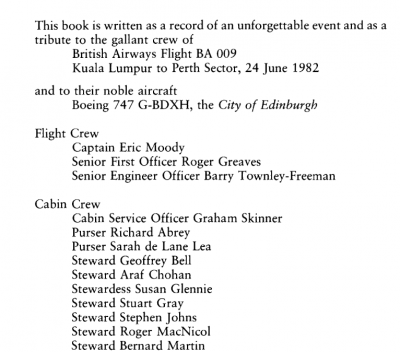
A: The List of Illustrations is still a list, along with Subheadings. The paragraphs are image descriptions, something you should take into account when you are describing the images. This page is a dedication. Add the Heading Dedication and you can apply the list style to the listed names. The meaning of the lists will be understood as the user reads the section. No need to add a heading to the photo section if there is none in the original.
Q: I have a question about the book "All four engines have failed".
In the Acknowledgements section there is a list of people and organizations (as seen in the image below). Each of the entries on this list contain multiple paragraph breaks. Since paragraph breaks would interfere with formatting these entries as a list, I was wondering if there was another approach I could take to make this section more accessible?

A: I am not sure what you mean about paragraph breaks. This looks like a list of the names and addresses. Apply the list style to this section and indent the contact information into a nested list. It would be something like:
- Name
- contact info
- Name
- contact info
Q: About This Digital Book in Buffalo Wild!
The template for this section says: "There are [insert number] levels of headings [and page navigation] in this digital book. Level 1 indicates top level, [type e.g. Chapter] headings. [Level 2 indicates…]."
When the page numbers are turned into headings as in picture books, does that count as a heading or as page navigation for the About This Digital Book section? That is, do I keep or remove the mention of page navigation?
A: Page navigation is only for page numbers, everything else is headings. In Picture Books it is headings as we did not insert page numbers.
Q: Ordered lists in Buffalo Wild!
A section contains a treaty, which contains a list of articles. The articles are titled as "Article 1", "Article 2", etc. Since they are numbered, I want to use a ordered list. But, that also sounds redundant: "1. Article 1" etc. What should I do?
Here is a portion of the treaty:
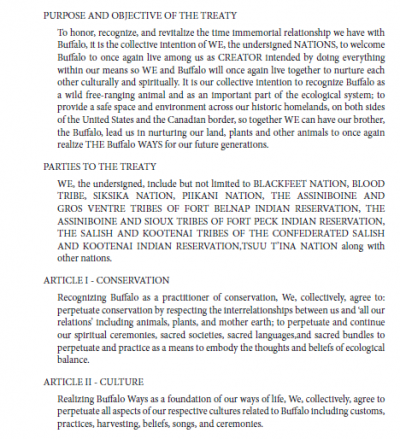
A: Those are headings. Lists are only for listed items, not for headings.
Q: Questions about pagination and the book: All Four Engines Have Failed.
1) Am I right in understanding the since there are page numbers in the original ebook (in this case a scanned pdf), I retain pagination in the word document by adding all page breaks and reformatting page numbers as PRINT PAGE #?
2) Since the header by the page number follows a consistent format (alternating between the book and chapter title), do I delete them?
3) Not a question but I noticed that the "Example of a Running Header" link on the "Headers / Footers" wiki page appears to be broken.
A: We always remove anything in a header or footer as it is not accessible (other than endnotes). Yes, follow the instructions on Page Numbers for how to insert page numbers. After I convert the book I can show you the code so you can see how it translates after conversion into EPUB3.
Q: Questions about tables in book: Teaching to Diversity
1) It seems there are two typos in the wiki for Tables. It should be “table properties” instead of “table priorities” (see attached image).
2) As for the title of table, I just want to confirm if my understanding is correct. If the table has a title, we just copy and paste the title into the Title field in table properties. If the table does not have a title, we should create a title based on the information of the table and then add it to the Title field in table properties.
3) I was a little confused to follow the steps to Identify a “Header Row” shown in the wiki. Once the “Header Row” check box is checked, I am not quite sure about the rest two steps, “Type (or retype) your column headings” and “Press the Enter key.” Would you please provide guidance or create a short video?
The following link is a video about “Repeat Header Rows”. We may add it to our wiki for reference. https://support.microsoft.com/en-us/office/video-create-accessible-tables-in-word-cb464015-59dc-46a0-ac01-6217c62210e5
4) As wiki mentioned, split or merged cells should not be used in a table. In the book, however, there are several tables with merged cells (see attached image as an example). How should we tackle such tables?
5) Tables on the last two pages of the book, the header row is the last row. I tried to set the “Repeat Header Rows” by following “Table Properties-Row”. The “Options” including the check box of “repeat as header row at the top of each page” is not active (greyed out). What is the best practice to handle those tables? Thank you.
A: I added the video and fixed the typos. See Tables for revisions.Yes, create a title. Spilt cells are not accessible, so we will always have to restructure the table in to either multiple tables, a nested list, or subheadings with a nested list. It all depends on the table. You will need to flesh out what the data is in the original table, and figure out how to best organize it so it is clear an accessible. This might be multiple tables, or even lists. If you require more assistance on this, please let me know and I can help you organize it.
For your second question, I already answered this below for Ensouling Our Schools.
Q: Ordered lists for series. In The Redemption.
In the Also by the Author section is a list of titles in a series where the last is numbered 0.5, and the author suggests reading it after Book 5 as though it is Book 6. In this section in another book of hers, the same title is numbered as 6, not 0.5. I have tried to adjust the numbering in the eText, but it seems like Word only allows whole numbers. Can I renumber Book 0.5 as 6?
A: Format the lists as unordered lists and add rephrase the items as Book 1: Ecanta etc..
Q: Another question on "Ghosthawk". There are two indigenous language words in the 'Acknowledgements' section of this book. They can be seen in the image below. I have marked them in strong style and started writing a producer's note. The Syilx people speak nsyilxcən so this is what I was going to put down but I could find no other reference to "ʔuknáqin" online so I was unsure what to do. Thanks!

A: If you are ever unclear about the languages, and can not find out through researching them, then you can use a more generic Producers note for Indigenous languages instead of specifically naming each language.
Q: I had a couple of questions about the poetry book "Ghosthawk":
1. There are several poems without titles and I was wondering if I should add some form of generic heading for these poems in order to better differentiate them from other poems and sections of the book. Three of these occur in the body of the book between the poems 'Snow Light' and 'What Was Coming'. All three are referenced in the table of contents (which I removed) by their first line. There is also a short poem before the first titled poem of the book. It is in italics and appears similar to an epigraph. A similar poem is found at the very end of the book (even after the 'About the Author'). I was unsure how to approach this problem. I found one example in the Q&A of a poetry book with no initial heading to differentiate it from the front matter so the heading 'Poetry' was applied. I was wondering if a similar approach should be taken here?
2. In a few of the poems the stanzas are separated by single asterisks (see example image below of poem 'Merlin'). My initial thought was that a content break should be applied but the language felt continuous so I thought I would check to make sure. There were some full page gaps between stanzas where I also applied content breaks.

A: When creating headings, a good place to look is the original table of contents, and then also the device table of contents. In this case, they do use the first line of poetry as a heading, so we can do the same. As for the section after About the Author, you can use the heading Closing as that is what the original uses. I made this video for further explanation of how to figure our headings with the TOC
You can use content breaks in place of the asterisks, as they are there to create visual pauses to break up the stanzas further. A content break will do the same thing for a screen reader.
Q: Questions about the book: Teaching to Diversity
1. There are several parts, like “Spotlight”, in the book (see attached image). I just want to confirm if it is correct to use a text box and move it to an appropriate place within main narrative flow.
2. There are small images (see attached image, in red circle), like “ST-V 1” and “ST-V 2”. Based on the Table of Content, I am thinking if we could transcribe the text of the image to the heading, i.e., “ST-V 1: T.” and then delete the small images in the Word file?
3. There are some icons in the book (see attached images). It seems that they are decorative images. Could I remove them in the Word file? Thanks.
A: You are correct, use a textbox as described on Textboxes & Sidebars: Secondary Content
Yes, you can create a heading with this transcribed images
No, you can not delete these images as the are not decorative. They bring meaning to the text and are custom icons. You will need to describe them using Simple level image description.
Q: In "A Soft Place to Fall" the author often uses italicized text to indicate something the protagonist is reading or has read. After reading the Q&A I saw that these could be dropped if it was obvious what the character was doing, such as reading a sign. In the case of this book, this occurred with signs, posters, clocks, and a birthday cake: "My name was written in blue icing: "Happy 15th Creigh"" (chapter 11). In these instances I did not re-add emphasis.
In other cases, while it was still obvious the italicized text was something the protagonist had read, special emphasis seemed to also be being placed on the text. The example in the image below is also from chapter 11. In this case I added emphasis. I was wondering if I approached this correctly. Thanks!

A: You are correct. If it is in a sentence like that and it is clear someone is reading you can remove the emphasis. If it is on its own you can use blockquote.
Q: I have a couple of questions about "The Bondage Breaker."
1. The copyright page was rendered as an image when it was converted. Should I describe it like an image with alt-text, or transcribe it directly into the text?
2. The eBook isn't consistent with giving the original page numbers. For example, after eBook page 80, they seem to disappear until page 96. Should I put in numbers when they're there, or leave them out altogether?
3. I think that there's supposed to be an image on eBook pages 50-51, but it didn't render properly. How should I tackle this?
A: Transcribe the copyright page directly. The numbers are super annoying! Just leave them out and make sure the About this digital book section includes the note about no page numbers.
Do you mean this weird part:
That is just some messiness from a low grade scan. You can remove it.
Q: caption and endnote questions for book: Christi Belcourt
Each image has a caption in two languages. One is in Indigenous language and the other is in English. There is a paragraph mark between them (see the image). By following the wiki, a caption should not be more than one paragraph long.
1. Could I copy and paste the two paragraphs together into the caption text cell? In such case, the caption will become one paragraph with both indigenous and English. There will be no paragraph mark in the caption (i.e., one paragraph).
2. The wiki gives instruction for caption style (i.e., Arial 12, Italic, Automatic for color). However, the captions of this book are in indigenous language. How should we mark up such captions?
3. Endnote question. This book has sections in indigenous language and the corresponding translated sections in English. There are endnotes in those sections. As a result, there will be two notes with the same meaning (e.g., same link or address) in two sections, i.e., one in indigenous section and the other in the English section. (See attached image). Is that right to ignore the relation between such two notes (i.e., same mean but in different languages and in different sections), and to mark them as different notes? Thanks.
A: For the captions, yes make them one line with no paragraph breaks. Just make a note in RT that the captions include Indigenous languages. I remove the strong style during conversion and replace it with the language tags for the given languages. It is right to ignore the relation between the two notes, as they are for two different sections (one in English, one translated into an Indigenous language.)
Q: How many Producer's Notes do I need? Book: Spirits of the Coast.
Spirits of the Coast requires a note about the numerous Indigenous languages in the text as well as notes about the one-page comic it contains. The example NNELS-Zilla text for comic books uses two Producer's Notes: one about how we describe comics and one about how comics tell stories. Should I create a third for the Indigenous languages note, or can I add it to the note about how we describe comics? When I try the former, that seems like a lot of separate sections. When I try the latter, the notes about the languages seems out of place when compared to the notes about the comics that uses H2 for About this Comic.
A: So we only do one Producer's Note per publication. You don't have to include the entire Comic Producer's note as it is only one image. You can include a paragraph that reads as follows:
This book includes a described comic. The editors have tried to describe this comic book to recreate the comic experience. Attention has been paid to the structure and layout of each page and panel in how it relates to the story being told. Instead of having chapter and section headings the comic is broken down into page headings and panel headings. We create these readers for you to enjoy, so we encourage you to share with us and feedback of comments you have about this reader so we can improve.
Q: In Peyakow, there are some mention of Indigenous tribe names from Argentina. Some examples are Selk'nam, Mapuche, and Kollas. I'm wondering how I should mark these for the producer's note, since it's only the tribe's name that's mentioned and not any words from their languages.
A: If you can not identify the language names, you can write that languages from these other tribes also appear in this publication and may not be properly pronounced by screen readers.
Q: Another 'Ensouling Our Schools' dilemma: there are several not-technically-tables that I'm converting into lists, but in the original, these tables sit right in the middle of another list. I imagine a list that breaks apart another list isn't all that accessible, so how should I tackle this one?
Edit: They're in Chapter 10, print pages 197-201 of the eBook.
A: You can use long description for each image.
Q: Another 'Ensouling Our Schools' question – I am not sure how to best tackle either of these:
a) 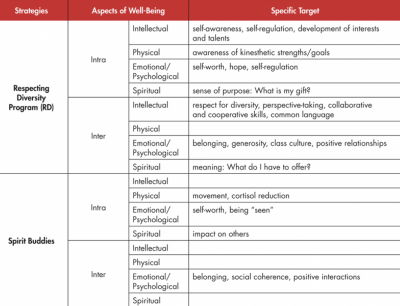 My first thought is to split it into separate tables somehow, but I'm not sure.
My first thought is to split it into separate tables somehow, but I'm not sure.
b)  This one relates to the surveys I asked about before; it's meant to create a visual graph of the results.
This one relates to the surveys I asked about before; it's meant to create a visual graph of the results.
A: Your instinct to break it up into smaller tables is correct. Good work! As for your second question, there is no way we can create an accessible version of drawing a visual graph in an EPUB. In this case, you would create a long description, where you would recreated the chart as a table with the bottom row as a header row.
Q: 'Ensouling Our Schools' has some surveys included as appendices, and I'd like to clarify on how to approach them. I'm thinking I should mark each section as a subheading, use unnumbered lists for the questions, and start each bullet point with '[BLANK].' Thoughts? Here's how it looks in the original:
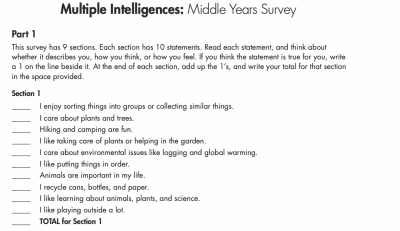
A: This is a correct approach, but do an ordered list instead of an unordered list.
Q: In Peyakow, the author inserts a poem with Spanish and English translation. I'm wondering if I should add a heading with the poem's title, since based on the context it's not that clear when the poem starts.

A: You can style it as a blockquote. In this context the poem is being quoted. You can also tell by how it is indented compared to the rest of the text. That is a visual cue of a blockquote.
Q: Can’t find some symbols to use for letters in Indigenous words. Book: Spirits of the Coast.
There are many, many, many words in this book that are from a few different Indigenous languages. I am trying to use the proper symbols for them, but can’t find them all in Word or in the Unicode resources listed on the Symbols page of the wiki. (I have restricted my searches to letters in the various Latin scripts because I assume that searching in other languages will end up coding things wrong.) Those I’ve found include: č, ł, Ḵ, ḵ. I can’t find the x that looks like it’s in superscript or the following letters with a line underneath: G, g, a. I expect to come across more in the text. What do I do with these letters? Is there somewhere else I can look?
A: Try expanding your search on the Unicode page. If you can not find it I did find this resource for Indigenous Unicode: First Nations Unicode Font
Q: Questions about the directions, index and language mark up for book: Truly Mexican
1) The Directions of a recipe may have several directions for preparing different parts of the recipe. Taking the “Red Snapper Papillotes in Green Mole (Page No. 158)” as an example, the directions include “Make the mole” and “Prepare the fish”. There are four paragraphs for “Prepare the fish”, and each paragraph may include several steps. Could we use two levels of ordered lists and format one paragraph as one item of the list? (See attached image) or Should we go further to format the paragraphs as multiple items of the entire ordered list?
2) As per the previous requirements of this ticket, I reformatted asides as text boxes. Could I delete the last sentence of “About this digital book” or rephrase the sentence as "All secondary content in this book has been placed into text boxes"?
3) As for the section of “Index”, “Index” was formatted as Heading 1 in the Word file, however, the subheadings, i.e., A, B, C, etc, were not formatted as Heading 2. Should I format them as Heading 2?
4) If I understand correctly, the Mexican names of recipes in yellow were provided after their English names. In the Word file, however, those names were not marked up as Spanish. Should we mark up them as Spanish?




A: the answers in order are as follows:
- Each individual step needs to be its own list item. In the example you show above you have multiple steps in one listed item. For the recipes that have more that have multiple directions, divide them with headings that are one level lower than the heading for Directions
- Delete it. If all the asides are in text boxes they will be marked up with <aside> tags that the user will be able to use to navigate and understand it is an aside. See wiki page on About this Digital Book for more on aside content
- Yes, please format them as heading 2
- Yes, please mark them up in Spanish
Q: The book "Ensouling Our Schools" uses a couple of original acronyms to explain the concepts in the book. For example, they use existing words like IMPROVE or ACCEPTS. Is it best to leave these capitalized, or to switch them to lowercase? I don't want to cause confusion as they're using words that already exist, unlike other acronyms like NASA. Here's what it looks like in the eBook, for context:

A: You can re capitalize them with only the first letter capitalized.
Q: Are these subheadings? In Spirits of the Coast
In the section called Artists’ Statements (where I have styled the words “Artists’ Statements” as Heading 1), I wonder if the names of the artists that follow in alphabetical order should be Heading 2. My instinct was that they should be, but then I looked at the next section…
In the section called Contributors (again, styled to Heading 1), there is a list of all the contributors in alphabetical order. In most cases, the name of the author starts the first sentence in the paragraph about them (in one case, the person’s name is several words into the first sentence). Should these names be styled as Heading 2, or should I create fresh headings with their names before the paragraph about them, or should I just leave all text in this section styled as Normal?
Here are examples: the first page of Artists’ Statements and two pages from Contributors. In the first page from Contributors is the example of a name midway through the first sentence (Jim Ryan). In the second page, are examples of a name being followed by apostrophe s, which makes for a weird subheading in itself (Tsaqwasupp Art Thompson’s (1948–2003) and Jared Towers’s).
A: The section Artist Statements you can set the name as H2 and the lines about the art as a caption for the thumbnail image.
The section for Contributors can just be normal without subheadings.
Q: For Peyakow: Reclaiming Cree Identity, the title page is formatted as such:
 The author's name, title, and subtitle are in textboxes that are tilted. I'm not sure if I should leave this as is, or I'm thinking I should remove the textboxes and add the text back as part of the main text. What do you think?
The author's name, title, and subtitle are in textboxes that are tilted. I'm not sure if I should leave this as is, or I'm thinking I should remove the textboxes and add the text back as part of the main text. What do you think?
A: The way it is formatted now it is not accessible. You will need to transcribe it into the document styled as Normal. We only use text boxes for asides as per the wiki instructions.
Q: Questions regarding heading, Italics, context breaks for the poetry: Blue Marrow
1) After the section of dedication, there is no heading (e.g., section, chapter, or poem title) for the main context. It may cause accessibility barrier because the context of main text is under the heading of dedication. What is the best practice to tackle such case?
2) This poetry has Cree language. The Cree words and prays are Italic in the book (see the screenshot as an example). Should we retain the Italics in place as the original book?
3) As the Wiki mentioned, we do not retain blank spaces between lines. However, there are some large blank spaces in the book (see attached images). To my understanding, such large blank spaces should be treated as context breaks. It that right?

A:
- You can insert the heading
Poetry - Yes. As per the wiki on poetry we retain italics. Please also follow the Indigenous Language markup and set them also as bold.
- You can insert content breaks in those larger spaces.
Q: Languages in Arab Cooking on a Prairie Homestead
The recipes in this book are sometimes given in both English and Arabic transliterated into Roman letters. For example, Garlic Soup / Shawrabat Thoom. In some cases, the Arabic words are common in English, such as hummus and tahini. I understand that when the words are common in English, we don’t mark them up. But what about when that word is within a phrase in the word’s original language? For example:
1. Chickpea Dip / Hummus Bi Tahini
2. Sesame Sauce / Salsat Tahini.
In these two examples, I’m inclined to mark up hummus and tahini because they wouldn’t be spoken with an English accent in the context. I think that follows the wiki guidelines under Languages, 3b.
A: Your instinct is correct here! In this usage it is a translation of the title of the recipe.
Q: Languages in Arab Cooking on a Prairie Homestead
Many Arabic words are repeated throughout the cookbook. For example, there is a whole chapter on the food kishk, which includes nine recipes for kishk served with different ingredients (such as kishk with lentils and kishk with eggs) and a preamble explaining its history. Should I mark up all uses of this word, even though it becomes very familiar in the text? (I might be mixing this up with an editing technique where the first instance of a foreign word is in italics, then the rest in normal.)
A: It is important to always be consistent. If you mark up the first instance of the word, then you should mark them all up. That editing technique you are referring to is mainly aesthetic, whereas in our work we are aiming for accessibility.
Q: Nested, unordered lists for references in Arab Cooking.
When formatting a list of references, I understand that we use unordered lists and nest entries when they are "alphabetically-related". When I create the nesting, should I keep or remove the "—." that otherwise begins the entry to show that the author is the same?
A: You can keep the m-dash when you nest the list.
Q: In Arab Cooking, there are several different ways that notes are presented within recipes. Some are in the sidebar, some follow the recipe with the word "Note:", and some follow the recipe and start with an asterisk. I understand that the asterisk is weird for a screenreader. Can I just change them to "Note:" like the others?
Examples: Note: Always set aside part of the yogurt for the next batch. vs. * Sumac can be purchased from Middle Eastern grocery stores.
A: I will need to see an example. We can go over this in our meeting tomorrow.
Q: In Arab Cooking on a Prairie Homestead, I'm wondering about the placement of images.
There are several chapters in this cookbook with columns of text, not recipes, and there are some images among the text. In the original, some of these images span more than one column or are placed mid-paragraph; as far as I've noticed, they do not correspond to specific paragraphs. I'm not using columns in my eText, but I wonder where to place these images in my eText. I'm tempted to place them between paragraphs to avoid breaking up the text. Here's an example:
A: Good intuition! Yes, put them between paragraphs so we don't break up the text.
Q: In Mind Hacking Secrets, and in general, how should we treat nonbreaking spaces? I saw few in one section, and I'm not sure if I leave them or replace with regular spaces. Also this section is missing some spaces in between words and sentences, but this is how it's formatted in the original and epub. Should I add spaces in or leave as is?
A: You can leave them as is, they do not have a negative impact with conversion to EPUB3.
Q: In Mind Hacking Secrets, the author uses mathematical symbols to explain a theoretical concept. They bold and italicize it in the original text. Should I format it like a math equation using Words Equation editor, or do I keep it as text and italicize?
A: You can remove both the italic and strong from this, and there is no need to use math equation.
Q: Stage directions in plays, as in Kim's Convenience
The wiki says that: "Stage directions are normally marked as normal text." I think I have found an exception, but please confirm. In Kim's Convenience, there are stage directions within dialogue that I think need to be highlighted somehow (because won't it be read or understood as dialogue since the character's name precedes it?). Here is an example:
A: Good intuition! This would be an exception. You can style it with emphasis style.
Q: Questions about page number, language, image for the novel: Iron Widow
1) The original ebook (PDF) has page numbers, and most of page numbers are at the top of page. However, there are several page numbers at the bottom of page, e.g., Page 1 and Page 9. (See the attached image please). Based on the section of Page Numbers in the wiki, two lines of “PRINT PAGE #” will be inserted closely in the reformatted Word file (See the attached image). I am wondering it may cause accessibility barriers by such two close lines of "PRINT PAGE #". Should I put the “PRINT PAGE #” on the top for the page whose page number in PDF file was at the bottom of page?
2) There are some pages without page numbers. For example, three pages (i.e., the blank pages and Part I title page) between Page 5 and Page 9 don’t have page numbers. Should I insert page numbers for them or leave as is?
3) Based on the section of Language in the wiki, if I understand correctly, we will not mark up the Chinese characters’ name in the novel. Is that right we only need to mark up those Chinese titles (e.g., jiejie, wushaoye, and baofengshaoye)?
4) There is no section title, chapter title or caption for the diagram with five elements. Could I place the diagram into the section of Book Summary? Also, that diagram in the unedited Word has been formatted into two images. Could I take a screenshot for the diagram and place the screenshot in the edited Word file? Thank you.
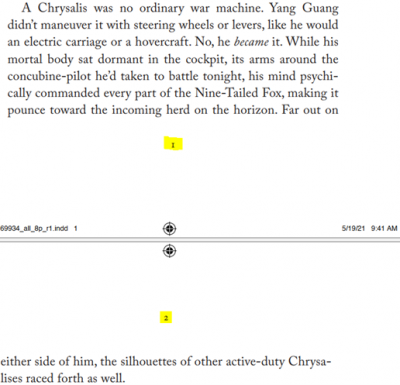

A:
- Yes, you can move all the print page numbers to be at the bottom of all the pages.
- The Part headings and Quotes will no longer be on their own page, as you will be creating them as headings, and those blank pages will not long exist, so you do not have to worry about them.
- Correct
- Keep it in the same location as the original. To extract an image, follow the instructions on Extract Images from PDF Files
Q: In Mind Hacking Secrets, I have some questions about the endnotes:
- The references in this book are just hyperlinks. Do I keep the hyperlinks or remove them and keep everything as only Endnote text style?
- When I paste the references back as endnotes, some paste with indents and some don't even though the original text doesn't have them. I can't seem to figure out why this is, as I tried removing these indents with no luck. Should I just leave it as is? I posted a picture of how my edited etext looks like.
A: We should rename the Hyperlink Text so it is more direct. For example, we can change the first one to bigthink.com article: This $100-million Startup Plans to Put Chips Into Human Brains to Enhance Intelligence.
To rename the Hyperlink text:
- Select the hyperlink text
- Right click to open the menu
- Select Hyperlink and select Edit Hyperlink
- This will open the Hyperlink dialogue box
- At the top of the window is a textbox labelled: “Text to Display”
- Enter updated display text.
Here is a video demo of https://somup.com/c3lIFmwafFHow to Rename the Hyperlink text
I am not sure why the endnotes are creating those indents without seeing your workflow. We can walk through this in our meeting on Thursday.
Q: Questions about the bold text and spelling in the novel: Sorry for Your Loss
1) In that novel, there were many phone text messages in bold (see the attached images please). I think the bold styling is just for visual purpose and didn't add additional meaning to text. Could we remove the bold styling of those text messages?
2) As can be seen from the images, some abbreviations were used in the messages, such as "r", "u", and "yrself". Those abbreviations may cause accessibility barriers to people with print disabilities when using screen readers. Should we replace those abbreviations with the full words?
3) Some emojis were used in the text messages, what is the best practice to treat them?
4) In the novel, several words with wrong spelling, such as "braaaaaaain","sooooo",and "loooong", were used to show people's feeling/thoughts. Should we leave them there or replace them with right spellings?
A: 1) Yes, remove the bold as it does not add meaning to the text, 2) We keep all abbreviations, and in this case it is imitating text speak. We are not editors, so we do not change the content of the original, only the formatting. 3) Emojis are considered symbols. For further instructions go to Symbols & Abbreviations/Acronyms on how to use unicode. 4) Those are not "wrong spellings" as this is a creative book and it was the intention of the author to imitate a speech pattern with the spelling. Again, we are not editors, our goal is to make books more accessible through reformatting and retain as much of the original as possible.
Q: Questions about page numbers with regards to the novel Ghost Lake.
Most of the pages within the novel's body text are numbered. The exceptions are the first page of each chapter and the page preceding it. In the pdf, these two pages have a background (see image below) and could perhaps be considered a two-page image. In the word doc, however, there is only a picture representing the chapter title, not the preceding page. The page numbers before and after these pages are in sequence as though both of these chapter heading pages are also numbered.
I understand that the numbered pages would have "PRINT PAGE #". Should I number the few non-numbered pages since they are in sequence? (I wonder if not numbering them would sound like something is missing.) If so, would the first of the two non-numbered pages be considered a blank page since in the word doc there is no picture?
A: These pages have no numbers, so we just leave them as is. Some books in fiction do not number all their pages, and we can only work off the original.
Q: Another Indigenous language and emphasis question, this time for Ghost Lake. I've come across several Ojibwe phrases that are then followed by English translations, and the translations are italicized. Should I use emphasis style on these translations?
In dialogue, the translations sort of read like thoughts to me. Here is an example:
“Nishkide’e, idash-nmno-bmaadiz,” I say. I’m sad, but doing alright.
This occurs throughout the novel in the narrative as well, and sometimes the English translation that follows the Ojibwe is not in italics. Here is an example of the former:
He notices movement in the distance, and sees his omishoomeyan, his stepfather coming down the hill towards him.
I`m thinking now to not set the italicized translations to emphasis style. They`re not really emphasizing, just repeating. A: From what you have explained here, it sounds like in this case it is used more for aesthetics than for adding meaning to the text. You can remove them.
Q: For Call Me Indian, in the pdf some words are hyphenated to wrap between two lines, and the hyphen is retained in the edited version. Do we remove those hyphens in the edited version?

A: You can remove this using Regex. You can find the instructions in second post on the Regular Expressions wiki page
Q: Couple questions about marking Indigenous languages:
- In Call Me Indian, the chapter's headings are written in Cree (I believe), followed by the English translation. Should I apply strong style to the Cree part on top of it being a Heading 1 already?
- If the proper name of a person has an English first name and Cree last name, should the whole name have Strong Style applied? Ex. Harris Wichihin, Herb Seeseequasis
A: As per the wiki instructions, we mark up all Indigenous words including words we would not mark up for other languages.
Q: In Call Me Indian, there's a few sentences with emphasis in the original that I'm not sure if I should keep.
- 'I heard a big thump, thump, thump.' (I think emphasis should be retained since it's a sound effect)
- 'In fact, one evening, when I was out in a bar in one of the small towns near the reserve, a fellow had come up to me, laughing, and said, “Hey, Freddy, remember all those names I used to call you when you played hockey?” Of course I did. Squaw humper. F-ing Indian.' (I feel like the meaning comes across without emphasis, but I'm not sure)
A: Both can keep emphasis: (1) is emphasizing the sound as you said, (2) looks like a thought.
Q: In Call Me Indian, when I removed formatting I noticed there was a paragraph break after 'But', but in the original text the paragraph is formatted properly. I'm guessing the paragraph break was added to fix justification in the original, but I'm wondering if I keep the paragraph break in the edited text or not?


A: We want to keep it as close to the original as possible. So remove the paragraph break. It breaks the sentence apart which is structurally and grammatically incorrect and will lead to reading comprehension issues for both screen reader users and other readers with print disabilities.
Q: In The Abyss Surrounds Us, I have found three Greek phrases (or rather, the same one repeated). In the original text, they are italicized and I used the emphasis style in my edited version. However, when I apply the strong style so that the language stands out when the book is being reviewed, the emphasis style seems to be removed. How should I mark up and comment on this for submission through RT?
A: It sounds like the emphasis was only there for aesthetic reasons and not to convey meaning. Remove the emphasis and keep the bold as per language directions.
Q: For clarification, should horizontal lines be added to context breaks that are only paragraph breaks, symbols etc? For example, in Call Me Indian I'm not sure if a section break between two pages could also be interpreted as a context break.

A: Good question! The *only* time you put in a horizontal rule is for a context break. See the definition on the wiki page for Context Breaks. This is a page break. We do not keep page breaks in the reformatted book.
Q: I'm working on The Abyss Surrounds Us, and wondering about methods for creating horizontal lines for context breaks. For my NNELS books, I've been using the method shown in the video of choosing "horizontal line" from the drop-down menu of the "Borders" function in the Home ribbon. In the past, I have also used the keyboard shortcut of three dashes following by the enter key. These result in different-looking lines, but have the same visual function. But I wonder: if I use this keyboard shortcut for etexts, will they be understood as a context break by the ereader?
A: Only use the method that is in the wiki. The directions in the wiki are designed to create an accessible book, when you deviate from those directions you can create accessibility issues. When you insert the Horizontal Rule it creates a string of code in the back end of the book. When the Word doc is converted to a EPUB3 that Horizontal Rule is converted to the line of code that tells the screen reader it is a context break. Anything else will not do the same thing.
Q: In Call Me Indian, there are decorative images on the sides of every page. I tried searching ^g and it doesn't pick up these marks. Some pages have multiple of these decorative images stacked onto each other. Is there another easy way to remove them all?

A: They are actually buried in a lower level of the document. Don't worry about these, they are used for printers to know where the gutter is for the page. I can deal with them during conversion.
Q: In The Bell Jar, the main character is also a writer, and the excerpts of her writing are in italics in the original text. I put them in Quote style in the edited text, is this correct?
A: The majority of these excerpts are presented like thoughts in the text, so they can follow the rule of emphasis and be styles in emphasis style. If there is ever a clear quote from her writing (i.e. it is made explicit in the surrounding text this is a quote) they apply the quote style.
Q: In Teaching Kids to Buy Stocks, there is a glossary of terms at the end of the book. Throughout the book the author highlights terms as 'Nerd Word Alerts', and compiled all the terms in this glossary. In the original ebook each word is stylized, so I'm wondering if I should make any changes or leave each term styled as Normal in the edited version. The image below is what it looks like in the original ebook.

A: The "Word Alerts" are what we call asides or secondary content. Learn how to format these at Textboxes & Sidebars. A glossary is a type of list, as noted on the lists page, anything that is a list must be formatted as a list. In this case you would style it as follows:
Glossary [Heading 1]
- [Unordered List] Term: definition following term
- Convertible Bond: A bond with a provision that lets you convert it to equity (stock shares) in the bond issuer. The share amount is predetermined by the issuer and available periodically during the life of the bond.
Q: In "Mille Secrets Mille Dangers," a lot of the dialogue is rendered as bulleted lists without quotation marks. Should I maintain this, or can I insert quotation marks and remove the list instead? As a note, I am confident enough in my French to figure out where the quotation marks should technically be. Here's an example from the original:
A: Keep the dashes, it is pretty standard in french books.
Q: The Last Hour of Gann again… I feel like I'm spending a lot of time (too much time) adding the emphasis style to replace italic text. Maybe I'm keeping too much of the italics/ emphasis. In the book, they are often used for titles and names (remove), thoughts (keep), and emphasis and tone in narrative and dialogue. It's the latter that I think I'm confused by–when is the information being conveyed by italics important enough to keep the italics? Here are some examples:
1. And no lights anywhere—anywhere—where they can be seen outside. (do the em dashes imply emphasis effectively here?)
2. “Yes, dammit!” Amber snapped. (does "dammit!" get the point across without italics?)
3. "Well,” she amended ruthlessly, “it’s this or go on the state or start whoring. I guess we do have options.” (Without the italics the meaning of the words doesn't change, but the speaker's tone is changed from sarcastic to matter-of-fact.)
4. Amber learned early that standing around in an skyport was pretty much exactly like standing around in an airport. This was probably because, regardless of the Director’s many efforts to make it look futurific and exciting, it was an airport, only with a space shuttle behind it instead of a bunch of planes. (again, it changes the tone not the meaning, but the tone shows the character's insight.)
A: Keep all of them. These are all examples of the style being used for emphasis.
Q: At the end of The Last Hour of Gann, there is an excerpt from the author's forthcoming book. This excerpt is about 3 pages in Word. Should I retain this? If so, is there preferred wording for a heading?
A: You can keep it. Heading can be Excerpt from (Title of Book)
Q: Title: The Last Hour of Gann
Location of issue: Chapter titles and sections–when to use Heading 2
"Book I" will certainly be Heading 1, but I'm not sure about including "Amber" with it or making "Amber" Heading 2. The TOC in the e-book makes it look like the full book/chapter title is "Book I Amber". Later in the chapter are sections 2, 3, 4, 5, and 6… section 1 is not named, and the word "Amber" is set apart from the text similarly to the numbers. Are "Amber" and section 1 the same? If this is the case, I think it should be set as Heading 2.
I hope that made sense! What do you think?
A: This one is a bit confusing. As the Book heading is visually separated from the other headings in the chapter, we can assume that the names and numbers are a separate heading level. Books are Heading 1 as they are the top sections, Names and Numbers and Heading 2 as they are the subsections within those sections.
Q: For Teaching Kids to Buy Stocks, there's some instances where terms are emphasized like this:
"The endcap makes me suspicious because I know it’s a game of psychology for marketers. I can’t help but tell my poor kids these things when we shop together. (Maybe that’s why I shop alone so much as they get older.)"
I think "that's" should remain emphasized, but I'm not sure if "psychology" should be emphasized. What do you think?
A: That is a bit of a judgement call. It looks like if falls within the scope for keeping emphasis style as outlined on Bold, italics, underline and strikethrough.
Q: Another "Nishga" question: Some of the PowerPoint slides included in the presentation transcription are just text, and they rendered as such during the conversion (instead of being images). Can I leave this as-is, or should I insert screenshots and write up alt-text instead? Here's the original, and it is on its own page in the pdf:

A: We want to stick to the original as much as possible. It appears that in the case the intention is to have an image of the text, as noted by the caption. Keep the image and do a long description for the transcribed text. You can also format the transcribed text with quote and citation style.
Q: "Nishga" has a section where the text includes a reference to images used earlier in the book. It refers to them by page number that isn't accurate after reformatting. Should I leave it, or is there another way to fix it up? For reference, the text looks like this:
A: For this book you can enter in the page numbers, if you follow the directions on the Page Numbers wiki page they will match up to the original.
Q: "Nishga" has a couple of interesting visual things going on. For the first screenshot, I'm not sure whether I should leave it as is or render it as an image and try to give an alt-text description. The context is that it was taken from a presentation given by the author and it's representative of a totem pole. For the second screenshot, I am not sure what to do with the blacked-out squares. There's no text behind/underneath them that I could strikethrough.
A: For the first one, given the context, you can keep it as an image and use a long description for the transcription. In the long description describe how the words look on the page, and then for the transcription simple transcript it like you would for poetry so a screen reader can read it. For the empty parentheses, insert the word Blank. For example: (Blank)
For the second part, this actually used to be on the wiki, but it seems to have disappeared. For black squares like this, keep the image, and describe it as a black rectangle blocking out text
Q: Is there a way to set up the styles side-pane to make it more effective and easier to find the style I'm looking for? On my microsoft version of MS word, the styles are shown in a scrolling window, and not like in the video (I think this is just a different edition difference). There are a lot of styles to scroll through and scrolling up and down seems to waste time. Is there a way I can pick and choose what styles I want to show up (specifically I'm looking to get rid of the part that lists the "para" and "text" styles as there are over 52 of them showing up)? Or is there a way to make it show the set up like in the video that shows the set up of a word document?

A: In all versions of MS Word the style pane includes a scrolling window. Which video are you referring to?
From the screenshot you posted it looks like you are using a version of MS Word on a PC. What I am going to tell you now is specifically for PC, Mac will have slightly different directions.
As per the video in Setting Up Word, it is recommended you have your style pane set to All Styles, as this means you will have access to all the styles you will need to reformat your book. Unfortunately, this does make a longer scroll window in the display area of the style pane. You can rearrange the way the styles are ordered though:
- Select
Optionsat the bottom of the Style Pane - This will open a new dialogue box labelled:
Style Pane Options - There are two dropdown menus at the top.
- The first menu is labelled:
Select Styles to Show - Select
All Styles - The second menu is labelled:
Select how list is sorted - Select
alphabetical - Select
Ok
Now the styles are in alphabetical order. You can also choose As Recommended, but this is not helpful at it will not show all the styles you want to use.
I made a quick video about the Options in Word for Windows, but it has no sound.
Another option is to apply shortkeys to the styles. You can learn more at Keyboard Shortcuts
I will add more information about the styles pane to the wiki next week.
Q: "Hunting By Stars" has a paragraph before the first chapter begins that's similar to a prologue or intro. It doesn't have a heading in the original, but I don't want it to be confused as a part of the dedication before it. Should I add in a heading, and if so, what should it be?
A: You can add the heading Prologue. A Prologue is an introductory section before the chapters of the book. This section name is found more in fiction titles
Q: I can't open the book with the thorium reader to verify with the text document. Is there a different program that can be used? I tried adobe but it said the document is damaged (I'm not sure if that is because it's just not supposed to be opened in Adobe. The book is "Bombs Always Beep".
A: It is a Kindle book (files ending in .azw3 are kindle files). You will need to open it is a Kindle reader, as it is only compatible with Kindle readers and will not open in other readers. Adobe is to open PDFs, and Thorium is to open EPUBs.
Go to the Kindle Reading app to download it for free.
Q: When working with different languages, how do we treat nouns that are sometimes common and sometimes proper, depending on the context? In "Dear Peter, Dear Ulla," for example, sometimes the characters will say "my mutti," meaning "my mama," and sometimes just "Mutti." I imagine consistency is best for clarity's sake, but I'm not sure which way to go!
A: Consistency is always important. Also remember, that sometimes screen readers will use a different voice for different languages, which can also cause an accessibility issue. In this case I would not assign language to either.
Q: I'm back with another page numbering question. The introduction to "What Comes From Spirit" is numbered with Roman numerals. Should I use Roman numerals in the reformatting? Also, the numerals start at 7 and end at 10…not sure what happened to 1-6, if that affects things!
A: Yes, you can use Roman Numerals. Some books like to number Introductions, Prefaces, and Prologues with Roman Numerals to show that they stand out from the rest of the book.
Most books do not start at page number 1 because they count the front matter pages (title page, half-title page, blank pages, copyright, dedication, etc.) but they don't necessarily assign the numbers to those pages. (i.e. you wont see them printed on the page or in the digital copy)
So if a book has say 6 unnumbered pages at the beginning, then the first numbered page is going to be 7. There is really not straight answer to why publishers do this, other that they have been for a long time so they don't change it.
Q: I had particular problems with the index, as I didn't quite grasp the line " To faciliate navigating an index, use nested lists to enclose alphabetically- and numerically-related entries. Many indexes include the number or letter as a heading" at first. The statement just got a little lost in the guide. Maybe that could be broken down a bit for furture trainees? Maybe an example to make it super clear?"
A: That is a bit of a convoluted sentence. I have updated the Index wiki page for clarity, and will send out an email to the team about the revisions. If you have any more questions about the Index, please post them here!
Q: "Dear Peter, Dear Ulla" frequently transitions back and forth between the main narrative and excerpts from letters the characters have sent each other. Is it best to divide these sections using horizontal lines, or to format the letters as block quotes? Or, something else!
A: Format the letters as Blockquotes.
Q: A follow-up to my last "What Comes From Spirit" question on page numbering: I had to go with option 2. Do I still include labels for the pages that were blank in the original? For example, each section has a blank page between the title and body.
A: Good question! It requires some testing for the best output, I will get back to you before the end of the week on this one. UPDATE: Thank you for your patience with this. You can follow the PRINT PAGE # with the phrase - Blank Page. See Page Numbers for more info
Q: The book "Border & Rule" doesn't have a title page. Should I create one? Also, should I include the author of the foreword and afterword on the title page, if I create one?
A:Yes, we would want to create a title page. When you look it up on Amazon, there is a title page in that version of the book. Please copy the information from there. Here is a video demo of what I mean.
Q: "What Comes From Spirit" by Richard Wagamese has a section called "Sources" that states where each short story/section was originally published. It references these in the book by page number. For example, the pieces on pages 11, 19, 21, 29 etc were originally posted on Wagamese's WordPress blog.
Should I include a Producer's Note for the numbering? I can go through and trade the numbers for the actual pieces, but notably many of them are untitled, so I'm not sure if that would make things more awkward and difficult to navigate. Right now, I just have the page numbers as an unnumbered list.
A: Good question, since not every section is properly named in this context we can actually retain the page numbers. You can insert page numbers as based on the PDF and insert numbering as per the PDF.There are two ways you can do this:
- Insert pages numbers in the Header of Footer. Microsoft Word allows you to use upper/lower roman numerals like i, ii, iii or Arabic numbering 1,2,3. Word has a built in workflow you can find on their webpage for Insert Numbers.
- If you find this method problematic with lining up the proper pages, then you can placing the page numbers at the start of a new line preceded with
PRINT PAGE(keep all caps). For example:PRINT PAGE 7
Remember to keep in the line about page navigation in the Producer's Note. Let me know if you have any more questions about this process.
Q: The text I am formatting has a number of pluralized acronyms, such as FTAs, EPZs, CEOs, TERFs… should these be changed to apostrophe "s" so that it can be read by a screenreader? Will "FTAs" be read as "F.T.as"?
A: It should be fine as is (i.e. FTAs). I am double-checking with our testers and will get back to you.
Q: If the characters are already included, is there anything I need to do? There are two chinese characters in the dedication, and there is an acronym with umlauts over the 'o'. From what I've read, I think I just leave those?
A: Replace the Chinese charaters using Unicode, and the accented words are fine. They may need to be marked up depending on the context. See more on how to use Unicode and when to markup languages see the Language Page.
If you need more clarification if a word/phrase should be marked up, then please post a question here with the title of the book, and the exact word/phrase in question
Q:Is there any way to ignore words like "US" when looking for capitalization? Or is it just a matter of going through all of them?
A: You will have to go through each. There may be a way to us Regex. You can learn more about how to use Regex on the wiki page Using Regex (Regular Expressions)
Q: In chapter 9, the section "Caregiver program" begins with a quote that says "[M]y employer…". Can I assume that when an editor uses square brackets to indicate they changed the quote, those need to be removed so the screenreader can read it? Or can the screenreader figure it out if it is left in?
If I do remove it, should I include something to indicate that I have changed what the original copy had? Do I put this in as a producer's note, and indicate the chapter and subtitle and what change was made?
A: You can just remove it for something a small as a capital letter. No need for a producers note. If it were a word or phrase, then you would leave the brackets in.
Q: I have a follow up question about the use of page numbers in “The Country will Bring Us No Peace”. The e-book is reflowable in Apple Books, Calibre, and Thorium so I can’t tell what the original page numbers are. I’m not sure how to approach this. Should I still use page numbers?
A: We do not retain page numbers, unless specifically requested. You do not need to add any page numbers, and if the book has running headers (page numbers and text in header or footer area of page) you will need to remove them. You can find directions on how to remove running headers in the Regex section of the wiki.
Q: I am currently working on "Render" and it seems that a large number of bookmarks were created in the conversion process. Should I delete these bookmarks and only leave the ones that I have created for hyperlinks?
A: You don't have to worry about those extra bookmarks, they don't make it through conversion. It is only the ones you create hyperlinks for that make it through.
Q: In the complete cooking for two cookbook, each chapter starts with an index of recipes and some of those recipes have a yellow or red square beside them indicating if the recipe is "fast" or "light". There is a legend at the bottom of the index. How should I handle this?
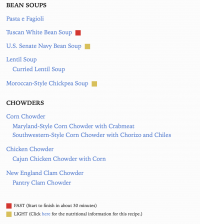
A: In the Alt-Text enter the word 'Fast' or 'Light' into the correct squares. I also noted there were instances where there were images of the actual words 'Fast' and 'Light'. For those instances replace with just the correct word and remove the image.
Q: And I actually have another question on this book (No Way Out). This is the first time I've seen a novel without any chapters at all. Even the beginning of the text, after the title page, dedication and publishing information, just starts with a blank page. So, I'm having a hard time deciding about headings. Should there be none at all? There are quite a few internal divisions marked by three asterisks that I'm replacing with horizontal lines, but nothing to indicate chapters of any kind. There are newspaper articles, emails, and dialogue transcripts interspersed throughout the story and I'm wondering whether I should format the first line of those as headings, both to distinguish them from surrounding text, and to add some sort of navigation tool?
A: In this case we can insert page numbers as based on the PDF. You can insert page numbers in the Header or Footer of the Word document and choose numbering as per the print book. Microsoft Word allows you to use upper/lower roman numerals like I, ii, iii or Arabic numbering 1,2,3.
Let me know if you have any more questions about this process.
Q: In No Way Out (a novel), there are a number of interview transcripts formatted the same way as plays (each new line of dialogue starts with the character's name followed by a colon). Am I good to apply Strong style to the characters' names the same way as I would in a play?
A: You are correct, you can format these sections as a play.
Q: In February’s Son, there are sections of text from the killer’s POV which are always on their own page, and styled with italics. Throughout the text I was planning on using context breaks to distinguish these sections, but there is one of these POV sections that comes after the epigraph but before the first top level heading that starts the body text of the novel (H1:10th February, 1973 H2: One). There is no section heading in the table of contents, but I wondered if I needed to add some kind of section heading to distinguish it from the epigraph section? Or should I leave as is?
A: Leave it as is. We are not editors, so we do not add this type of formatting to books.
Q:A questions regarding headings in There be Pirates. I understand from the Wiki that I need to nest headings without skipping (Styles and Headings). I'm currently using Chapter Headings [Heading 1], Section Headings [Heading 2] and Asides [Heading 3]. These nest appropriately in all sections except for the beginning of the introduction in which asides that appear before any section headings, so I go from Introduction [Heading 1], to Heading 3 for these asides. I'm wondering the best way to proceed in this section… do I use heading 2 style for the asides in the introduction or leave as is?
A: You always follow the rule of hierarchy. This rule is based on creating accessible navigation and less on the visual order of the headings. Nest headings without skipping. For example, if you have a book with two levels of headings, use Heading 1 and Heading 2, not Heading 1 and Heading 3, no matter how small or insignificant the second level of heading might appear. It’s very important to not skip heading levels as the document will not validate as an accessible ebook. In this case, the asides in the first section are Heading 2. If you skip a heading the reader will become confused and lost as it reads as if there is a heading missing from the navigation.
This is listed in the general rules for headings on the Styles & Headings page in the wiki.
Q: Question regarding the placement of the book summary section. I've included this section for the information on the front cover flap of "Thanks for the Business" but I am unsure of where this should be placed in the order or the book. Prior to the title page section, or after?
A: We do not keep any cover information. So anything from the cover can be removed.
Q: Quick question about Faith that Works. There are some photos at the end that I'm wondering whether I should keep and add alt-text to or just delete. They are at the very end under the section "Ten Point Plan for Gospel Advancement" which isn't part of the main book. To me, it looks more like the advertising material publishers sometimes put at the back of books.
A: Good question! You can remove the images but keep the text and apply nested lists. This is a list of resources, so you can also create a heading 'Resources'
Q: This is a question about headings and navigation. I'm working on The Good Turn. The book is divided into parts with chapters within the parts, which is all very straightforward. But there are two places where I'm not sure what to do. The first is that there are sections called "Anna" that present a different character's point of view. They are also sometimes in a different timeline from the main narrative. I think they should be H1 level, like the Part headings but I'm not sure since they are more like chapters. I'm wondering whether I should actually put them as H2, even though one of them occurs before Part One begins. I'm not sure which is better for navigation. The other place I'm not sure about is the dates that are placed BEFORE the chapter or part headings. Usually the date/location comes after like on Page 9 and 83 but in some places like page 157 and page 211, a new date is placed between chapters. Is it okay to move the date just after the chapter heading instead of leaving it before? It seems like navigation would be improved if I did but I know we generally try to leave the text alone as much as possible so I wanted to check what you thought was best.
A: Great Question! You should never edit a book, but if you are unsure ask! We want to recreate the book as close to the original as possible. Remember, this is copyrighted material, so we can't actually edit anything or move things into a new order, we just have to do our best to make it as assessable as possible with reformatting.
I looked at this title, and you are so right, these headings confusing. A good rule of thumb is to remember we are working with a Hierarchical structure for headings. This means H1 is always followed by H2, which is always followed by H3, and so on. Here is a link to the wiki that explains this a bit more.
A good way to help figure this out is look at the original PDF (you should always be looking at the original ebook as you publish your books to make sure you are following the right formatting as needed)
For example, the first time you see
THE GOOD TURN Dublin, Ireland Tuesday 1 September 2015 ANNA
at the beginning of the etext, this is actually three pages. One is an additional title page, which you can delete in this instance, and the others are the section headings that are divided by pages. Sometimes publishers use blank pages for breaks.
So the first page has the heading
Dublin, Ireland Tuesday 1 September 2015
You want to mark this as one full heading as follows
Dublin, Ireland: Tuesday 1 September 2015 (heading one because it is the first section after the Title page and front matter, it is not a subsection so it gets heading one)
The next page has 'Anne' in smaller font and underlined. That can be set to Heading Two as it is a subsection of the previous heading followed by text.
Then you have this own page in the PDF
PART ONE Galway, Ireland Saturday 31 October 2015
This can be split into two headings levels following our rule for navigational hierarchy
Part One (H1)
Galway, Ireland: Saturday 31 October 2015 (H2)
All the chapters under this last H2 heading will be H3 (chapter 1-10)
Another trick to help you is to note the font and layout style in the original PDF.
All the Heading Ones and twos are on their own page, and the Heading threes are on a separate page (usually before the body text) a smaller font and underlined. These are visual clues on how to help you structure the headings. The first section is an exception because we have to follow the rule of hierarchy. We also know all Parts get top headings, so that will move down all following Location: Date headings to H2 and all Chapter and Anna headings to H3 as per the rule of hierarchy.
Then you go into the next part and start again.
It will look as follows:
- Dublin, Ireland: Tuesday 1 September 2015 (h1)
- Anna (H2)
- Part One (H1)
- Galway, Ireland: Saturday 31 October 2015(h2)
- Chapter 1 (H3)
- Chapter2
- Chapter 3
- Chapter 4
- Chapter 5
- Chapter 6
- Chapter 7
- Chapter 8
- Chapter 9
- Chapter 10
- Dublin Ireland: Tuesday 1 September 2015 (H2)
- Anna (H3)
- Part 2 (H1)
- Galway, Ireland: Monday 2 November 2015 (H2)
- Chapter 11 (H3)
and so one until you get to the Epilogue and other back matter which are all H1.
Q: Hello, I'm working on Powwow Summer. The .doc file has been converted from a PDF file. I can't figure out how to get rid of the grey page colour in the .doc file. I've attached a screenshot to show you what it looks like.
It's not grey shading of the text, it's the page itself. It doesn't seem to be a graphic that I can delete, like it usually is. I tried making the paper letter sized (it was smaller with non existent margins on the left to start with so that's why I adjusted the paper size, because I wanted to make sure it was all left justified). When I did that, the grey background only took up the original paper size so now it has white margins on the right and bottom. But I still can't get rid of the remaining grey. When I google the problem, I just find instructions for removing grey background from text, not from the page itself. I also tried copying and pasting the text into a new document but the grey page background came with it. And I have cleared formatting several times. Any suggestions on how to get the page background all white?
A: This is an example where Word can be very tricky. So it is an image that exists on a separate pane, and is located in the header. There are also two levels of grey squares you will need to delete.
In order to delete
- Go to the Layout tab in the Ribbon Menu
- Select Selection Pane. This will open a new work area to the right of the document.
- Navigate to the page with the image you need to delete
- Open the header and footer by double clicking the top of the page (this is the location in the document where this second grey image is.)
- Select the image you wish to delete. In this case it is the Images that are labelled as Rectangle.
- This will select the image directly in the document
- click in the document and select Delete
Here is a video demonstrating how this works.
NOTE: When you are resizing the page layout please make sure you are doing it with direct formatting. First, select the entire document, then go the Layout tab in the Ribbon Menu and select 8x10 (do not select the borderless option.) We need to be careful and consistent if we are resizing a document to avoid any error.
Q: There is a thank you for buying this e-book published by Hachette Digital blurb at the end of The Shack Revisited. Should I set it at header 1 or should I do something else with it?
A: You can simply remove this entire section.
Q: Another question about "What the Bible is All About". This is about the glossary. It gives a pronunciation guide for many of the terms (eg. "eunuch (YOO-nuhk)" ) which includes uppercase letters to show which syllable receives the emphasis. Is it okay to leave all the uppercase letters alone and add a Prod Note explaining that screen readers may not pronounce the pronunciation guide portions correctly?
A: Yes, we can just leave as is written, since that’s the way to indicate pronunciation. An optional producer’s note at the beginning of the section is a good idea! ![]()
Q: The book I'm working on has the following section near the beginning:
Ebook Instructions In this ebook edition, please use your device's note-taking function to record your thoughts wherever you see the bracketed instructions [Your notes] or [Your response]. Use your device's highlighting function to record your response whenever you are asked to checkmark, circle, underline, or otherwise indicate your answer(s).
I'm unsure how to handle this since the end user won't be able to record their notes or responses in our version. Should I leave it in or delete it?
A: You can remove this section.
Q: My current book has a lot of instances of a symbol with "L SEP" in a dotted lined box. So far, they all look like they could be replaced with a space. Is there a known way to use Find and Replace to easily replace these?
A: So that box means there was an issue with the font when it was converted. First, make sure what the box is representing. In the case of your file it is representing a blank space. As far as I have been able to research, this is the main thing it tends represent, but it is best to be safe and just double check. The quickest way to do this is using your Find & Replace window.
- First open your Find & Replace window,
- and then select the L SEP box with your cursor, make sure it is highlighted,
- and copy it.
- Then past it into the find box and hit find all.
It will show you every location it is in the file, then you can just scan through and ensure that it is only representing a blank space. If this is the case then you can use the Find & Replace window to replace them all. To do this simply
- put your cursor into the Replace box and hit your space bar once,
- then hit Replace All
and you are done! Here is a link to a video that shows you what I did: https://screencast-o-matic.com/watch/cqjODGtbvf
I will also update the Find & Replace section of the wiki to show these instructions.
Q: Further to the question below, the book I'm working on has hundreds of instances where a space between two words was missing. It seemed like some kind of conversion glitch rather than a typo or mis-spelling. Is it okay to re-insert the spaces so that TTS software can read it better?
A: Good eye. You are correct in your assumption. So these are not spelling mistakes, but an error that can occur in conversion with some types of books. You can get this A LOT with PDF's, or books that used hard hyphenation in the ebook. In these cases you will want to go through and re insert those lost spaces. Unfortunately, currently we do not have a way to do this other than manually. If you figure out a faster way to do it let us all know. Good luck and thanks for taking this on!
Q: I feel this was addressed somewhere else, but I cannot find where. If we come across a spelling error made in the original work, do we leave them as is?
A: You leave any spelling errors as is. Our jobs are to reformat the books, so we avoid edits of the content as much as possible. Let me know if you need more clarification on this.
Q: Just a quick clarification on the remove all page breaks request…does this mean that every page should just continue on to the next? Even between different chapters?
A: Yes, all page breaks should be removed, unless the user has requested that pagination be retained. To remove all page breaks, you can do a Find and Replace:
Find: ^m
Replace:
^m stands for manual page break.
Q: What do we do if we notice an obvious formatting error in the ePub version (and Word version) of the book? In Sex Made Easy, there are numbered subheadings and the author has written #70 twice and has skipped #72. Is this something I should correct?
A: We should reflect the original text, errors and all (unfortunately we're not editing for writing). We can tell the reader about this issue in the Producer's Note section of the book.
Q: Cooking for Two has an extensive index with no page numbers, but each work is linked to the relevant recipe. I know we would normally delete this and replace with our own producers note, but this also has information about the TOC so I just wanted to check! Thanks.
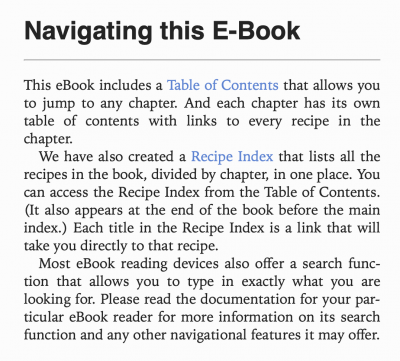
A: We can remove this section as it is about the original ebook and not the reformatted version. We remove TOC's from the eText (even the ones at the beginning of the chapter.) You can retain the links, just check them to make sure they go to the right places (hint: in document links are always bookmarks, so you may need to open those up to examine them.)
Q: In Baby Girl: Better Known as Aaliyah, there's an editor's note below the Index heading: "A note about the index: The pages referenced in this index refer to the page numbers in the print edition. Clicking on a page number will take you to the ebook location that corresponds to the beginning of that page in the print edition. For a comprehensive list of locations of any word or phrase, use your reading system’s search function."
I know I need to add a Producer's Note. Am I right to assume I need to remove all the links in the index (but leave the page numbers)? And should I also remove this note?
A: We remove all page numbers unless specifically requested by the patron. In this case, the page numbers were not asked for, so we remove them. It there are page numbers in the book, or running headers, there is a way to remove them using Find and Replace. You can find the instructions on this page. Yes, you would remove all the links in the Index as well, and you can remove that note as it is about the original ebook version and not about the converted version we are creating. The producer's note you would use is found in the wiki section on Indexes.
Q: I am working on Prairie Fire and I've noticed that some of the language used in the book is not appropriate now (e.g; "Indians" being used to describe Indigenous people could be offensive to a lot of people). Is this something that we can make a note about at the top, something along the lines of "The language used in this book may misrepresent some Indigenous people or be considered offensive". Or should I just leave it be?
A: (I moved your image question to the Alt-text Q&A page)So in this case it is all about context. This is a historical book about a specific time, and the writers explain their work in the introduction. It was also written in 1994 when the word was more commonly used in a historic and political context. I did some more digging into the book, and one author is a university professor who has done extensive writing in Indigenous histories, and the other is a former director of the Treaty and Aboriginal Rights Research Centre of Nova Scotia who has even appeared in court to defend treaty rights. This is always a topic of discussion in libraries and publishing, and as a digital library, we can help give context to the book as we present it in the repository, but not in the book itself. I will be taking this question to the rest of the senior staff as well to get their feedback. Great Question! I will update this answer once we settle on the best way to approach this book.
Q: I'm working on Lucy Growing Up Human (a delightful PDF haha) and I have a couple heading questions. First, the first page of the book is like a character list (see image below). Should I leave the heading as "growing up human" (as it appears to be on that page), or should I add a heading for "Character list" or something? Second, there is the section of photographs in the middle chapter 6. Once again there is a heading called "growing up human". Should I leave this heading and leave the section in the middle of the chapter, or leave the heading but move to the end of the chapter? Thanks for your help! These headings always feel less straightforward in these PDFs.
A: I always want to apologize for the fun of PDF's, especially these ones that are scanned from old print books! Keep the first heading as is, as we don't want to change too much of the original. Move the second heading and section to the end of that chapter to avoid any navigation confusion. Remember to apply a lower heading level to the picture section as it is a subsection to the chapter. Thanks!
Q: I'm working on Sister Outsider; there are two pages in the back matter with links leading off to publisher reading lists/catalogs and a newsletter sign up (one page is Crossing Press; one page is for Penguin Random House). Do I delete these pages? If not, what heading should I give them?
A: Good question. You can delete these sections
Q: This is for Prarie Fire. In the endnotes, before the endnotes start, there is a little preface with the different acronyms and their long versions. How do I add this in? Just make a section before the endnotes named "NOTES" and have it written in?
A: Sneaky. You could add those before the Terms of Use section and give it a heading of Acronyms.
Q: Could there be a wiki page for general paragraph/body content formatting? Do I need space between paragraphs? Should I left-align body content for ease of editing? I feel like I did some of these things during testing but I couldn't find information about it on the Wiki.
A: So we don't do anything special to body content other than clearing formatting so it is set to Normal, adding complex formatting as needed (lists, emphasis, block quote), and removing extra spaces (including paragraph breaks (that was asked on the test), tabs, carriage breaks, etc.)
The Styles & Headings page talks about how we build up a book after clearing formatting. There is a tip in there about spacing, and I added a not about Justification for clarity: https://bclc.wiki.libraries.coop/doku.php?id=public:nnels:etext:styles_headings
Q: One more question about Orange Shirt Day! Each chapter has review questions and some of the questions in Chapters 4, 5, 6, and 7 ask you to fill in the blank. The blanks were removed from the word document I'm working on, but I'm not sure how to add them back in in an accessible way. Thanks for your help!
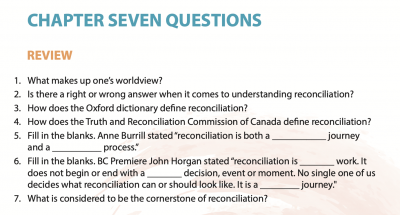
A: Good question. You can treat it the same way you would for transcribing a form with blanks. Replace with [blank]. See more in Images of Text
Q: Another question for "Angel Wing Splash Pattern," in the short story "The Night Charles Bukowski Died" each paragraph is formatted as one long sentence with no commas, semi-colons, or periods, which seems like it would make it very difficult to follow the story through a screen reader. I know we are not editors and we are not supposed to add anything to the text, so I am wondering if I should include a producer's note stating that the original story does not contain proper punctuation marks? Or if there is another way to make the story more accessible? I have included a screenshot of one of the longer paragraphs for an example.

A: We are not editors, adding punctuation would break copyright law. It would also be purely subjective, as you do not know the authors intent, and they can not weigh in on the changes. We never make such content changes in respect to the author and copyright laws in Canada.
Q: I took the ticket for Kamik Takes the Lead. Most of the images in this book look broken (see example below). I found the wiki page for extracting images. I was wondering if that is the appropriate step to follow to fix this book?
A: This happens all the time with PDF's, and can happen with some FXL (fixed layout) EPUBS as well. You can follow the directions on how to export images from a PDF. Let me know if you are having any issues with getting the images, and I can extract them for you.
Q: I am working on Qaqavii which has a Q&A with the author section at the end and I'm unsure if I should do any special formatting to designate the questions and answers. In the ebook the questions are bolded. I think I've used nested lists for Q&As in the past, but in this case the authors answers are often several paragraphs long so I"m not sure if this is the best approach. Thanks for your help?
A: You can leave the Questions Bolded in this context.
Q: I am working on "Arrows in a Quiver". I am a bit confused about how to section out these headings:
I know that part of it has to be done in caption formatting (under the image). How do I section out the part before (Map 4, Historical Treaties, Source)?
A: Great question. I opened up the book to look at the context, and in this case you should put all the information in the caption (no paragraph breaks.) If you created a heading then all the text under that heading would become part of a book section titled 'Map #' and that would be changing the meaning of the book.
Q: 4-Hour Workweek. 3 questions.
1. There are large spaces throughout the book that the designer used to signify content shifts. They are always followed by the first few words of the following paragraph styled as All-Caps. I would like to add horizontal rules here because I think it would help clarify the content shift. I'll attach several examples that are marked up with the location of the break. Lemme know what you think.
2. Related: Chapter 7 opens with two times that look like they could be headings, but then there’s a large paragraph space and the subsequent text does not seem like it belongs under a heading called “3:45 p.m.” Does it make more sense to just leave the times as normal text on their own line? Should there be a line break between the second time paragraph and the content below it (per the previous question)?
3. Related: Chapter 7 continues to be a demon, and it has two numbered sections that are themselves separated by a large space and nothing more; the numbers look like they should be headings given the complexity of the content beneath them, but what ends up happening is that in the navigation we have this structure: Chapter 7 –> Time Wasters: Become an Ignoramus
- 1
- 2
- 1
- 2
- 3
- etc.
A:
- The meaning can be gleamed by reading the text, so there is no need to add the content break.
- Leave these as normal text. Their meaning can be understood by reading without extra formatting.
- When the list item is a single block of text (one paragraph) style it as a list. When the list has item is more than a single block of text (two or more paragraphs). The lists that happen after "It is your job to train those around you to be effective and efficient." have more than a single block of text, so the numbers can be subheadings. The meaning of those subheadings can be understood as the reader reads the book, so it will be okay. We can only do so much with what we have.
Q: I'm still working on L'animal langage, but again this question/comment relates to all French books.
As discussed in our PA meeting, I've noticed that there are cases where a space appears before a piece of punctuation. And by space, I mean SPACE. As in, there are no print characters defining this space. I'm removing them as I see them, but I think they're literally impossible to find using Find/Replace.
What I'm wondering is if these even format when you convert the word doc to ePub. If there's no printing space, does that mean there's no tag on the ePub XHTML view? And if there's no tag, does that mean this quirk of MS Word doesn't end up causing the accessibility issues we're worried about (ie—does the space disappear during conversion)?
As noted, I'm deleting these as I find them, but they're very very easy to miss so I'm wondering how concerned we need to be. In the attached screenshot you can see there's a totally blank space between "moderne" and the semi-colon.
A: Good question. White spaces do not create tags, but create pauses. These should not cause accessibility issues. Has this come up in all the French books? Or just the one you are working on now? One thing you can do is turn on your computers TTS and have it read that section of text, keep in mind TTS is not as advanced as screen readers. These spaces look more like a Word glitch than anything else, but please send me a document with a sample and I can test it on my end. You can email it to me.
Q: Pilleurs de rêves has an image of the back cover with a book summary and a blurb about the author. I've transcribed both and put the latter under "À propos de l'auteur" but what is the French translation that we should use for "Book Summary"?
A: Résumé du livre
Q: Le Drap Blanc has a Remerciements section followed by a Dédicace. After the Dédicace is an Acknowledgement section for government support. A PA previously asked what to do with this final section here in the Q&A (for Pendent que Perceval Tombait). The answer was that this should be labeled: Remerciements. But Le Drap Blanc already has a section with this title. Should I have two sections with the same name? Should I move the Dédicace to the end (which would probably constitute "editing" so I'm thinking no). Other option?
A: In this case we can move it, as it is not part of the Dedication. It is not something we want to get into the habit of, but we have to work with what we have.
Q: Le Drap Blanc. There are a number of photographs throughout the course of this book. Some have nothing beneath them, some have text that, in the epub, look like normal text (see photo). Some of the text reads like a caption, but sometimes it just reads like a musing or random thought that only tangentially relates to the photograph. Should I leave this text as normal text or format the text as a caption?
In this example image, the text translates as: "He had posted some photos and postcards on the door of the refrigerator, or else on the door of his room."
A: Style them as normal.
Q: Le Drap Blanc. There are some … and — used to indicate that someone answering a question said nothing. Normally I'd put [blank] here, but since this is a French book, should I put… [vide]?
A: Using the french version of "Blank" is correct. The correct french translation to use is [tirets]. I ran this by our translator. I also updated the Text and Image page to include the french version.
Q: Another question from Le Drap Blanc. I could use some advice on how to style this section (see photo).
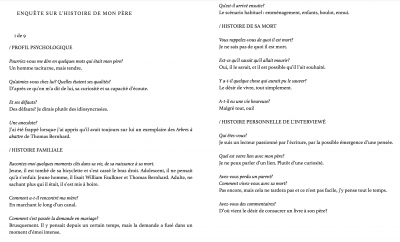
Here's what I'm thinking:
h1: "Enquete sur 'l'histoire"…
h2: 1 de 9
h3: Profil Psychologique
I get stumped by the "conversation" part. Do I do emphasis on the questions? Or do I leave the questions as normal and do quotation styles for the answers? Other ideas?
A: The heading structure you chose makes sense! You can style both the questions and answers as normal as the meaning can be gleamed from reading the text.
Q: Another We Rise Again question. After the table of contents (deleted) and before the "Foreword" are two images. The second image is paired with a caption and some other text. Should I move these images under "Foreword" in the formatted doc? Is there another heading I should put them under. Right now the heading that directly precedes them is "Dedication" (because of the deleted table of contents).
Here is the photo with text:
The bottom text I would style as a caption and I'm thinking the other text is a quotation/citation.
A: It is important to keep the original reading order of the book. In this case a lot of these pages are 2 page spreads as it is a fixed layout formatted title. The image with the caption on the next page can go under Forward to match where its caption is. Remember, we don't want to reorder books as we are not editors, but this book has a lot of weird formatting.
Q: I am currently working on Queer Returns, and there is one weird file issue. In chapter 9 there is what looks to me like a picture caption, but there is no image? I'm not sure how to proceed here. Thanks for your help!

A: It looks like a reference to the essay itself. All the essays have citations to their original publications.
Q: When setting the document properties, if the file came with additional info, do we leave it alone or delete it? For example, the document I'm working on now (Working from Home) has keywords and comments included.
A: Great question! You leave it alone.
Q: At the end of the book there is a section titled "Gemma Gorga and Sharon Dolin" that introduces the author and the translator. Can I group them under a section of "About the Authors" or should I name the section as "About Gemma Gorga and Sharon Dolin" to avoid confusion of their roles?
A: Apply the appropriate heading style to "About Gemma Gorga and Sharon Dolin" as it is what is in the original. When they read the section their roles in the work become clear.
Q: Same question as the above for the "Also by" section.
A: Apply appropriate heading level to "Also by Gemma Gorga" See Also by the author section of the wiki for more guidiance.
Q: A Thousand Times also has an image by itself after the title page and before the publication information. It's not decorative as it's referenced later in the text. What should I use as a heading?
A: No heading needed, just describe the image.
Q: In the wiki generally a title page immediately follows the cover page, and extra title pages are deleted. "Before the Usual Time" has two title pages, one immediately following the cover that has only the title, and one that has title, editor, and publisher info and comes after the publisher information. The wiki says the title page should generally have title, author, and publisher info, so it would seem better to keep the second title page. Should I move it to immediately follow the cover page, or keep the order of cover-about this digital book-producer note-title page?
A: Title pages always come after the Cover, otherwise it could confuse the reader as the front matter order is most always Cover-Title Page. Remember, the order of the Book Sections in the wiki are the order of the sections in a book. The only thing that can change usually is the publishing info sometimes appears at the end of a book (and we keep it there when it does)
Q: Two poetry formatting related questions for "Environment" in the collection "Before the Usual Time":
1. There are some words written in sub-script. Is there a way to retain this formatting or to retain the meaning? Or should I just format normally and put in the producer note that the formatting was not retained?
2. There appears to be some stylistic choices made in regards to paragraph breaks (ex. "upon the bastions of your fragile consciousness (para break) each lie another piece (para break)), which leads me to believe that I should keep all the paragraph breaks as they appear in the .pdf version. However the hyphen in "de-vours" also indicates that some lines do wrap, and should not have the paragraph breaks. Should I use my judgement to put in paragraph breaks (ex. should there be a paragraph break between "weight" and "of" on the first/second line, or is that one line wrapping?), or should I keep it exactly how it appears in the .pdf?
A: (1) Add note to Producers Note. (2) We are not editors, so only do it exactly as it appears in the .pdf. We do not want to break copy right law.
Q: One more "Before the Usual Time" question: the short story "A Fresh Start" contains a stylistically formatted transcription of what appears to be an email type message.

I'm assuming I would not keep all the extra line breaks and would change to regular sentence case, but is there any other formatting I should apply here? The preceding sentence has "came to life with the message:" so should I tag the email transcription as a block quote?
A: In this context, applying the quote style will help add meaning to the text for better accessibility. I would also change the Subject to Pascal Case. There is a note and example about Pascal Case on the Capitalization page
Q: In the book Theres Something in The Water there is a section in the first chapter where a section of legislation is quoted (under the "The Environmental Racism Prevention Act" subsection of Chapter 1). Would it be best to format that as an ordered list? Or should it just be blocked off as a quote?
A: That can be formatted as a blockquote.
Q: For block quotes and epigraphs that have an author listed it says to tag the author in the 'citation' style, but for in text citations we wouldn't have to go through and tag each in text citation in the 'citation' style, right? The bracketed author/date in text citations would just stay as normal text?
A: Great question. You are correct, we do not mark up in-text citations. I created a page on the wiki about this titled In-Text Citations and References for more information.
Q: I'm working on Redlocks and the Three Bears. I've formatted all of the pages according to the wiki. However, on one spread, one sentence is spread across two pages. I know we don't normally spread a sentence across two lines, and this seems particularly problematic because there is a heading and an image description between the two parts. Should I leave as is, or should I have the entire sentence on one of the pages?

A: Definitely not ideal, but we can only work with what we have. Leave the sentence split as it is what is done in the original.
